Agriculture
| Agriculture |
|---|
 |
|
|
Agricultureencompasses crop andlivestockproduction,aquaculture,fisheries,andforestryfor food and non-food products.[1]Agriculture was the key development in the rise ofsedentaryhumancivilization,whereby farming ofdomesticatedspecies created foodsurplusesthat enabled people to live in cities. While humans started gathering grains at least 105,000 years ago, nascent farmers only began planting them around 11,500 years ago. Sheep, goats, pigs, and cattle were domesticated around 10,000 years ago. Plants were independently cultivated in at least 11 regions of the world. In the 20th century,industrial agriculturebased on large-scalemonoculturescame to dominate agricultural output.
As of 2021[update],small farmsproduce about one-third of the world's food, but large farms are prevalent.[2]The largest 1% of farms in the world are greater than 50 hectares (120 acres) and operate more than 70% of the world's farmland.[2]Nearly 40% of agricultural land is found on farms larger than 1,000 hectares (2,500 acres).[2]However, five of every six farms in the world consist of fewer than 2 hectares (4.9 acres), and take up only around 12% of all agricultural land.[2]Farms and farming greatly influencerural economicsand greatly shaperural society,effecting both the directagricultural workforceand broaderbusinessesthat support the farms and farming populations.
The major agricultural products can be broadly grouped intofoods,fibers,fuels,andraw materials(such asrubber). Food classes includecereals(grains),vegetables,fruits,cooking oils,meat,milk,eggs,andfungi.Global agricultural production amounts to approximately 11 billion tonnes of food,[3]32 million tonnes of natural fibres[4]and 4 billion m3of wood.[5]However, around 14% of the world's food is lost from production before reaching the retail level.[6]
Modernagronomy,plant breeding,agrochemicalssuch aspesticidesandfertilizers,and technological developments have sharply increasedcrop yields,but also contributed toecological and environmental damage.Selective breedingand modern practices inanimal husbandryhave similarly increased the output of meat, but have raised concerns aboutanimal welfareand environmental damage. Environmental issues includecontributions to climate change,depletion ofaquifers,deforestation,antibiotic resistance,andother agricultural pollution.Agriculture is both a cause of and sensitive toenvironmental degradation,such asbiodiversity loss,desertification,soil degradation,andclimate change,all of which can cause decreases in crop yield.Genetically modified organismsare widely used, althoughsome countries ban them.
Etymology and scope
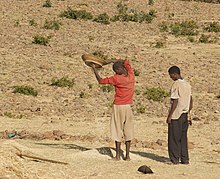
The wordagricultureis a lateMiddle Englishadaptation of Latinagricultūra,fromager'field' andcultūra'cultivation' or 'growing'.[7]While agriculture usually refers to human activities, certain species ofant,[8][9]termiteandbeetlehave been cultivating crops for up to 60 million years.[10]Agriculture is defined with varying scopes, in its broadest sense using natural resources to "produce commodities which maintain life, including food, fiber, forest products, horticultural crops, and their related services".[11]Thus defined, it includesarable farming,horticulture,animal husbandryandforestry,but horticulture and forestry are in practice often excluded.[11] It may also be broadly decomposed intoplant agriculture,which concerns the cultivation of useful plants,[12]andanimal agriculture,the production of agricultural animals.[13]
History
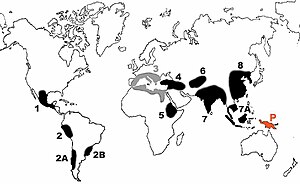
Origins
The development of agriculture enabled the human population to grow many times larger than could be sustained byhunting and gathering.[16]Agriculture began independently in different parts of the globe,[17]and included a diverse range oftaxa,in at least 11 separatecenters of origin.[14]Wild grains were collected and eaten from at least 105,000 years ago.[18]In the Paleolithic Levant, 23,000 years ago, cereals cultivation ofemmer,barley,andoatshas been observed near the sea of Galilee.[19][20]Rice wasdomesticated in Chinabetween 11,500 and 6,200 BC with the earliest known cultivation from 5,700 BC,[21]followed bymung,soyandazukibeans. Sheep were domesticated inMesopotamiabetween 13,000 and 11,000 years ago.[22]Cattle were domesticated from the wildaurochsin the areas of modern Turkey and Pakistan some 10,500 years ago.[23]Pig productionemerged in Eurasia, including Europe, East Asia and Southwest Asia,[24]wherewild boarwere first domesticated about 10,500 years ago.[25]In theAndesof South America, the potato was domesticated between 10,000 and 7,000 years ago, along with beans,coca,llamas,alpacas,andguinea pigs.Sugarcaneand someroot vegetableswere domesticated inNew Guineaaround 9,000 years ago.Sorghumwas domesticated in theSahelregion of Africa by 7,000 years ago. Cotton was domesticated in Peru by 5,600 years ago,[26]and was independently domesticated in Eurasia.In Mesoamerica,wildteosintewas bred intomaize(corn) from 10,000 to 6,000 years ago.[27][28][29]Thehorsewasdomesticatedin theEurasian Steppesaround 3500 BC.[30] Scholars have offered multiple hypotheses to explain the historical origins of agriculture. Studies of the transition fromhunter-gathererto agricultural societies indicate an initial period of intensification and increasingsedentism;examples are theNatufian culturein theLevant,and the Early Chinese Neolithic in China. Then, wild stands that had previously been harvested started to be planted, and gradually came to be domesticated.[31][32][33]
Civilizations

In Eurasia, theSumeriansstarted to live in villages from about 8,000 BC, relying on theTigrisandEuphratesrivers and a canal system for irrigation. Ploughs appear inpictographsaround 3,000 BC; seed-ploughs around 2,300 BC. Farmers grew wheat, barley, vegetables such as lentils and onions, and fruits including dates, grapes, and figs.[36]Ancient Egyptian agriculturerelied on theNile Riverand its seasonal flooding. Farming started in the predynastic period at the end of thePaleolithic,after 10,000 BC. Staple food crops were grains such as wheat and barley, alongside industrial crops such asflaxandpapyrus.[37][38]InIndia,wheat, barley andjujubewere domesticated by 9,000 BC, soon followed by sheep and goats.[39]Cattle, sheep and goats were domesticated inMehrgarhculture by 8,000–6,000 BC.[40][41][42]Cotton was cultivated by the 5th–4th millennium BC.[43]Archeological evidence indicates an animal-drawnploughfrom 2,500 BC in theIndus Valley civilisation.[44]
In China, from the 5th century BC, there was a nationwidegranarysystem and widespreadsilk farming.[45]Water-powered grain mills were in use by the 1st century BC,[46]followed by irrigation.[47]By the late 2nd century,heavy ploughshad been developed with iron ploughshares andmouldboards.[48][49]These spread westwards across Eurasia.[50]Asian rice was domesticated 8,200–13,500 years ago – depending on themolecular clockestimate that is used[51]– on the Pearl River in southern China with a single genetic origin from the wild riceOryza rufipogon.[52]InGreeceandRome,the major cereals were wheat, emmer, and barley, alongside vegetables including peas, beans, and olives. Sheep and goats were kept mainly for dairy products.[53][54]
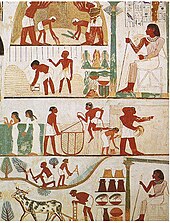
In the Americas, crops domesticated inMesoamerica(apart from teosinte) include squash, beans, andcacao.[55]Cocoa was domesticated by the Mayo Chinchipe of the upper Amazon around 3,000 BC.[56] Theturkeywas probably domesticated in Mexico or the American Southwest.[57]TheAztecsdeveloped irrigation systems, formedterracedhillsides, fertilized their soil, and developedchinampasor artificial islands. TheMayasused extensive canal and raised field systems to farm swampland from 400 BC.[58][59][60][61][62]In South America agriculture may have begun about 9000 BC with the domestication ofsquash(Cucurbita) and other plants.[63]Cocawas domesticated in the Andes, as were the peanut, tomato, tobacco, andpineapple.[55]Cotton was domesticated in Peru by 3,600 BC.[64]Animals includingllamas,alpacas,andguinea pigswere domesticated there.[65]InNorth America,the indigenous people of theEast domesticated cropssuch assunflower,tobacco,[66]squash andChenopodium.[67][68]Wild foods includingwild riceandmaple sugarwere harvested.[69]The domesticatedstrawberryis a hybrid of a Chilean and a North American species, developed by breeding in Europe and North America.[70]Theindigenous people of the Southwestand thePacific Northwestpracticedforest gardeningandfire-stick farming.Thenatives controlled fireon a regional scale to create a low-intensityfire ecologythatsustained a low-density agriculturein loose rotation; a sort of "wild"permaculture.[71][72][73][74]A system ofcompanion plantingcalledthe Three Sisterswas developed in North America. The three crops werewinter squash,maize, and climbing beans.[75][76]
Indigenous Australians,long supposed to have been nomadichunter-gatherers,practised systematic burning, possibly to enhance natural productivity in fire-stick farming.[77]Scholars have pointed out that hunter-gatherers need a productive environment to support gathering without cultivation. Because the forests of New Guinea have few food plants, early humans may have used "selective burning" to increase the productivity of the wildkarukafruit trees to support the hunter-gatherer way of life.[78]
TheGunditjmaraand other groups developedeelfarming and fish trapping systems from some 5,000 years ago.[79]There is evidence of 'intensification' across the whole continent over that period.[80]In two regions of Australia, the central west coast and eastern central, early farmers cultivated yams, native millet, and bush onions, possibly in permanent settlements.[33][81]
Revolution
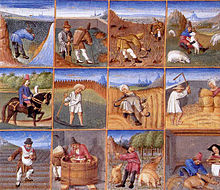
In theMiddle Ages,compared to theRoman period,agriculture in Western Europe became more focused onself-sufficiency.The agricultural population under feudalism was typically organized intomanorsconsisting of several hundred or more acres of land presided over by alord of the manorwith aRoman Catholicchurch and priest.[82]
Thanks to the exchange with theAl-Andaluswhere theArab Agricultural Revolutionwas underway, European agriculture transformed, with improved techniques and the diffusion of crop plants, including the introduction of sugar, rice, cotton and fruit trees (such as the orange).[83]
After 1492, theColumbian exchangebrought New World crops such as maize, potatoes, tomatoes,sweet potatoes,andmaniocto Europe, and Old World crops such as wheat, barley, rice, andturnips,and livestock (including horses, cattle, sheep and goats) to the Americas.[84]
Irrigation,crop rotation,andfertilizersadvanced from the 17th century with theBritish Agricultural Revolution,allowing global population to rise significantly. Since 1900, agriculture in developed nations, and to a lesser extent in the developing world, has seen large rises in productivity asmechanizationreplaces human labor, and assisted bysynthetic fertilizers,pesticides, andselective breeding.TheHaber-Boschmethod allowed the synthesis ofammonium nitratefertilizer on an industrial scale, greatly increasingcrop yieldsand sustaining a further increase in global population.[85][86]
Modern agriculture has raised or encountered ecological, political, and economic issues includingwater pollution,biofuels,genetically modified organisms,tariffsandfarm subsidies,leading to alternative approaches such as theorganic movement.[87][88]Unsustainable farming practices in North America led to theDust Bowlof the 1930s.[89]
Types


Pastoralisminvolves managing domesticated animals. Innomadic pastoralism,herds of livestock are moved from place to place in search of pasture, fodder, and water. This type of farming is practised in arid and semi-arid regions ofSahara,Central Asia and some parts of India.[90]

Inshifting cultivation,a small area of forest is cleared by cutting and burning the trees. The cleared land is used for growing crops for a few years until the soil becomes too infertile, and the area is abandoned. Another patch of land is selected and the process is repeated. This type of farming is practiced mainly in areas with abundant rainfall where the forest regenerates quickly. This practice is used in Northeast India, Southeast Asia, and the Amazon Basin.[91]
Subsistence farmingis practiced to satisfy family or local needs alone, with little left over for transport elsewhere. It is intensively practiced in Monsoon Asia and South-East Asia.[92]An estimated 2.5 billion subsistence farmers worked in 2018, cultivating about 60% of the earth'sarable land.[93]
Intensive farmingis cultivation to maximise productivity, with a low fallow ratio and a high use of inputs (water, fertilizer, pesticide and automation). It is practiced mainly in developed countries.[94][95]
Contemporary agriculture
Status


From the twentieth century onwards, intensive agriculture increased crop productivity. It substituted synthetic fertilizers and pesticides for labour, but caused increased water pollution, and often involved farm subsidies.Soil degradationand diseases such asstem rustare major concerns globally;[96]approximately 40% of the world's agricultural land is seriously degraded.[97][98]In recent years there has been a backlash against theenvironmental effectsof conventional agriculture, resulting in theorganic,regenerative,andsustainable agriculturemovements.[87][99]One of the major forces behind this movement has been theEuropean Union,which first certifiedorganic foodin 1991 and began reform of itsCommon Agricultural Policy(CAP) in 2005 to phase out commodity-linked farm subsidies,[100]also known asdecoupling.The growth of organic farming has renewed research in alternative technologies such asintegrated pest management,selective breeding,[101]andcontrolled-environment agriculture.[102][103]There are concerns about the lower yield associated withorganic farmingand its impact on globalfood security.[104]Recent mainstream technological developments includegenetically modified food.[105]
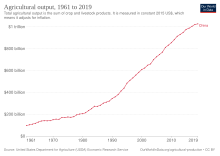
By 2015, the agricultural output of China was the largest in the world, followed by the European Union, India and the United States.[106]Economists measure thetotal factor productivityof agriculture, according to which agriculture in the United States is roughly 1.7 times more productive than it was in 1948.[107]
Agriculture employed 873 million people in 2021, or 27% of the global workforce, compared with 1 027 million (or 40%) in 2000. The share of agriculture in global GDP was stable at around 4% since 2000 - 2023.[108]
Despite increases in agricultural production and productivity,[109]between 702 and 828 million people were affected by hunger in 2021.[110]Food insecurity and malnutrition can be the result of conflict, climate extremes and variability and economic swings.[109]It can also be caused by a country's structural characteristics such as income status and natural resource endowments as well as its political economy.[109]
Pesticide use in agriculture went up 62% between 2000 and 2021, with the Americas accounting for half the use in 2021.[108]
TheInternational Fund for Agricultural Developmentposits that an increase insmallholder agriculturemay be part of the solution to concerns aboutfood pricesand overallfood security,given the favorable experience of Vietnam.[111]
Workforce
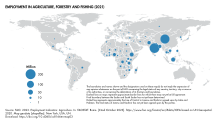
Agriculture provides about one-quarter of all global employment, more than half in sub-Saharan Africa and almost 60 percent in low-income countries.[112]As countries develop, other jobs have historically pulled workers away from agriculture, and labour-saving innovations increase agricultural productivity by reducing labour requirements per unit of output.[113][114][115]Over time, a combination of labour supply and labour demand trends have driven down the share of population employed in agriculture.[116][117]
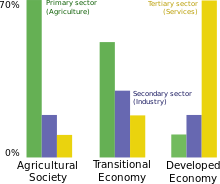
During the 16th century in Europe, between 55 and 75% of the population was engaged in agriculture; by the 19th century, this had dropped to between 35 and 65%.[118]In the same countries today, the figure is less than 10%.[119] At the start of the 21st century, some one billion people, or over 1/3 of the available work force, were employed in agriculture. This constitutes approximately 70% of the global employment of children, and in many countries constitutes the largest percentage of women of any industry.[120]The service sector overtook the agricultural sector as the largest global employer in 2007.[121]
In many developed countries, immigrants help fill labour shortages in high-value agriculture activities that are difficult to mechanize.[122]Foreign farm workers from mostly Eastern Europe, North Africa and South Asia constituted around one-third of the salaried agricultural workforce in Spain, Italy, Greece and Portugal in 2013.[123][124][125][126]In the United States of America, more than half of all hired farmworkers (roughly 450,000 workers) were immigrants in 2019, although the number of new immigrants arriving in the country to work in agriculture has fallen by 75 percent in recent years and rising wages indicate this has led to a major labor shortage on U.S. farms.[127][128]
Women in agriculture
Around the world, women make up a large share of the population employed in agriculture.[129]This share is growing in all developing regions except East and Southeast Asia where women already make up about 50 percent of the agricultural workforce.[129]Women make up 47 percent of the agricultural workforce in sub-Saharan Africa, a rate that has not changed significantly in the past few decades.[129]However, theFood and Agriculture Organization of the United Nations(FAO) posits that the roles and responsibilities of women in agriculture may be changing – for example, from subsistence farming to wage employment, and from contributing household members to primary producers in the context of male-out-migration.[129]
In general, women account for a greater share of agricultural employment at lower levels of economic development, as inadequate education, limited access to basic infrastructure and markets, high unpaid work burden and poor rural employment opportunities outside agriculture severely limit women's opportunities for off-farm work.[130]
Women who work in agricultural production tend to do so under highly unfavourable conditions. They tend to be concentrated in the poorest countries, where alternative livelihoods are not available, and they maintain the intensity of their work in conditions of climate-induced weather shocks and in situations of conflict. Women are less likely to participate as entrepreneurs and independent farmers and are engaged in the production of less lucrative crops.[130]
The gender gap in land productivity between female- and male managed farms of the same size is 24 percent. On average, women earn 18.4 percent less than men in wage employment in agriculture; this means that women receive 82 cents for every dollar earned by men. Progress has been slow in closing gaps in women's access to irrigation and in ownership of livestock, too.[130]
Women in agriculture still have significantly less access than men to inputs, including improved seeds, fertilizers and mechanized equipment. On a positive note, the gender gap in access to mobile internet in low- and middle-income countries fell from 25 percent to 16 percent between 2017 and 2021, and the gender gap in access to bank accounts narrowed from 9 to 6 percentage points. Women are as likely as men to adopt new technologies when the necessary enabling factors are put in place and they have equal access to complementary resources.[130]
Safety
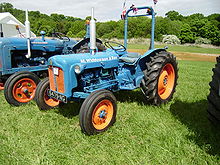
Agriculture, specifically farming, remains a hazardous industry, and farmers worldwide remain at high risk of work-related injuries, lung disease,noise-induced hearing loss,skin diseases, as well as certain cancers related to chemical use and prolonged sun exposure. Onindustrialized farms,injuries frequently involve the use ofagricultural machinery,and a common cause of fatal agricultural injuries in developed countries istractor rollovers.[131]Pesticides and other chemicals used in farming can behazardous to worker health,and workers exposed to pesticides may experience illness or have children with birth defects.[132]As an industry in which families commonly share in work and live on the farm itself, entire families can be at risk for injuries, illness, and death.[133]Ages 0–6 may be an especially vulnerable population in agriculture;[134]common causes of fatal injuries among young farm workers include drowning, machinery and motor accidents, including with all-terrain vehicles.[133][134][135]
TheInternational Labour Organizationconsiders agriculture "one of the most hazardous of all economic sectors".[120]It estimates that the annual work-related death toll among agricultural employees is at least 170,000, twice the average rate of other jobs. In addition, incidences of death, injury and illness related to agricultural activities often go unreported.[136]The organization has developed theSafety and Health in Agriculture Convention, 2001,which covers the range of risks in the agriculture occupation, the prevention of these risks and the role that individuals and organizations engaged in agriculture should play.[120]
In the United States, agriculture has been identified by theNational Institute for Occupational Safety and Healthas a priority industry sector in theNational Occupational Research Agendato identify and provide intervention strategies for occupational health and safety issues.[137][138] In the European Union, theEuropean Agency for Safety and Health at Workhas issued guidelines on implementing health and safety directives in agriculture, livestock farming, horticulture, and forestry.[139]The Agricultural Safety and Health Council of America (ASHCA) also holds a yearly summit to discuss safety.[140]
Production
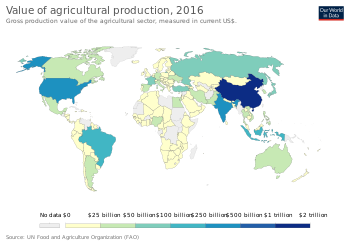
Overall production varies by country as listed.
| Largest countries by agricultural output (in nominal terms) according toIMFandCIA World Factbook,at peak level as of 2018 | ||||||||||||||||||||||||||||||||||||||||||||||||||||||
|---|---|---|---|---|---|---|---|---|---|---|---|---|---|---|---|---|---|---|---|---|---|---|---|---|---|---|---|---|---|---|---|---|---|---|---|---|---|---|---|---|---|---|---|---|---|---|---|---|---|---|---|---|---|---|
| ||||||||||||||||||||||||||||||||||||||||||||||||||||||
| Largest countries by agricultural output according toUNCTADat 2005 constant prices and exchange rates, 2015[106] | ||||||||||||
|---|---|---|---|---|---|---|---|---|---|---|---|---|
| ||||||||||||
Crop cultivation systems

Cropping systems vary among farms depending on the available resources and constraints; geography and climate of the farm; government policy; economic, social and political pressures; and the philosophy and culture of the farmer.[142][143]
Shifting cultivation (orslash and burn) is a system in which forests are burnt, releasing nutrients to support cultivation of annual and thenperennialcrops for a period of several years.[144]Then the plot is leftfallowto regrow forest, and the farmer moves to a new plot, returning after many more years (10–20). This fallow period is shortened if population density grows, requiring the input of nutrients (fertilizer ormanure) and some manualpest control.Annual cultivation is the next phase of intensity in which there is no fallow period. This requires even greater nutrient and pest control inputs.[144]
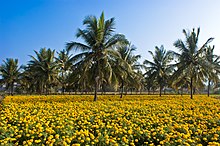
Further industrialization led to the use ofmonocultures,when onecultivaris planted on a large acreage. Because of the lowbiodiversity,nutrient use is uniform and pests tend to build up, necessitating the greater use ofpesticidesand fertilizers.[143]Multiple cropping,in which several crops are grown sequentially in one year, andintercropping,when several crops are grown at the same time, are other kinds of annual cropping systems known aspolycultures.[144]
Insubtropicalandaridenvironments, the timing and extent of agriculture may be limited by rainfall, either not allowing multipleannual cropsin a year, or requiring irrigation. In all of these environments perennial crops are grown (coffee, chocolate) and systems are practiced such asagroforestry.Intemperateenvironments, where ecosystems were predominantlygrasslandorprairie,highly productive annual farming is the dominant agricultural system.[144]
Important categories of food crops include cereals, legumes, forage, fruits and vegetables.[145]Natural fibersinclude cotton,wool,hemp,silk andflax.[146]Specific crops are cultivated in distinctgrowing regionsthroughout the world. Production is listed in millions of metric tons, based onFAOestimates.[145]
| Top agricultural products, by crop types (million tonnes) 2004 data | |
|---|---|
| Cereals | 2,263 |
| Vegetables and melons | 866 |
| Rootsandtubers | 715 |
| Milk | 619 |
| Fruit | 503 |
| Meat | 259 |
| Oilcrops | 133 |
| Fish (2001 estimate) | 130 |
| Eggs | 63 |
| Pulses | 60 |
| Vegetable fiber | 30 |
| Source:Food and Agriculture Organization[145] | |
| Top agricultural products, by individual crops (million tonnes) 2011 data | |
|---|---|
| Sugar cane | 1794 |
| Maize | 883 |
| Rice | 722 |
| Wheat | 704 |
| Potatoes | 374 |
| Sugar beet | 271 |
| Soybeans | 260 |
| Cassava | 252 |
| Tomatoes | 159 |
| Barley | 134 |
| Source:Food and Agriculture Organization[145] | |
Livestock production systems

Animal husbandry is the breeding and raising of animals for meat, milk,eggs,orwool,and for work and transport.[147]Working animals,including horses,mules,oxen,water buffalo,camels, llamas, alpacas, donkeys, and dogs, have for centuries been used to help cultivate fields,harvestcrops, wrangle other animals, and transport farm products to buyers.[148]
Livestock production systems can be defined based on feed source, as grassland-based, mixed, and landless.[149]As of 2010[update],30% of Earth's ice- and water-free area was used for producing livestock, with the sector employing approximately 1.3 billion people. Between the 1960s and the 2000s, there was a significant increase in livestock production, both by numbers and by carcass weight, especially among beef, pigs and chickens, the latter of which had production increased by almost a factor of 10. Non-meat animals, such as milk cows and egg-producing chickens, also showed significant production increases. Global cattle, sheep and goat populations are expected to continue to increase sharply through 2050.[150]Aquacultureor fish farming, the production of fish for human consumption in confined operations, is one of the fastest growing sectors of food production, growing at an average of 9% a year between 1975 and 2007.[151]
During the second half of the 20th century, producers using selective breeding focused on creating livestockbreedsandcrossbreedsthat increased production, while mostly disregarding the need to preservegenetic diversity.This trend has led to a significant decrease in genetic diversity and resources among livestock breeds, leading to a corresponding decrease in disease resistance and local adaptations previously found among traditional breeds.[152]

Grassland based livestock production relies upon plant material such asshrubland,rangeland,andpasturesfor feedingruminantanimals. Outside nutrient inputs may be used, however manure is returned directly to the grassland as a major nutrient source. This system is particularly important in areas where crop production is not feasible because of climate or soil, representing 30–40 million pastoralists.[144]Mixed production systems use grassland,foddercrops and grain feed crops as feed for ruminant and monogastric (one stomach; mainly chickens and pigs) livestock. Manure is typically recycled in mixed systems as a fertilizer for crops.[149]
Landless systems rely upon feed from outside the farm, representing the de-linking of crop and livestock production found more prevalently inOrganisation for Economic Co-operation and Developmentmember countries. Synthetic fertilizers are more heavily relied upon for crop production and manure use becomes a challenge as well as a source for pollution.[149]Industrialized countries use these operations to produce much of the global supplies of poultry and pork. Scientists estimate that 75% of the growth in livestock production between 2003 and 2030 will be inconfined animal feeding operations,sometimes calledfactory farming.Much of this growth is happening in developing countries in Asia, with much smaller amounts of growth in Africa.[150]Some of the practices used in commercial livestock production, including the usage ofgrowth hormones,are controversial.[153]
Production practices

Tillage is the practice of breaking up the soil with tools such as the plow orharrowto prepare for planting, for nutrient incorporation, or for pest control. Tillage varies in intensity from conventional tono-till.It can improve productivity by warming the soil, incorporating fertilizer and controlling weeds, but also renders soil more prone to erosion, triggers the decomposition of organic matter releasing CO2,and reduces the abundance and diversity of soil organisms.[154][155]
Pest control includes the management of weeds, insects,mites,and diseases. Chemical (pesticides), biological (biocontrol), mechanical (tillage), and cultural practices are used. Cultural practices include crop rotation,culling,cover crops,intercropping,composting,avoidance, and resistance. Integrated pest management attempts to use all of these methods to keep pest populations below the number which would cause economic loss, and recommends pesticides as a last resort.[156]
Nutrient managementincludes both the source of nutrient inputs for crop and livestock production, and the method of use of manure produced by livestock. Nutrient inputs can be chemical inorganic fertilizers, manure,green manure,compost and minerals.[157]Crop nutrient use may also be managed using cultural techniques such as crop rotation or afallowperiod. Manure is used either by holding livestock where the feed crop is growing, such as in managed intensive rotational grazing, orby spreadingeither dry or liquid formulations of manure on cropland orpastures.[154][158]

Water managementis needed where rainfall is insufficient or variable, which occurs to some degree in most regions of the world.[144]Some farmers use irrigation to supplement rainfall. In other areas such as theGreat Plainsin the U.S. and Canada, farmers use a fallow year to conserve soil moisture for the following year.[159]Recent technological innovations in precision agriculture allow for water status monitoring and automate water usage, leading to more efficient management.[160]Agriculture represents 70% of freshwater use worldwide.[161]However, water withdrawal ratios for agriculture vary significantly by income level. In least developed countries and landlocked developing countries, water withdrawal ratios for agriculture are as high as 90 percent of total water withdrawals and about 60 percent inSmall Island Developing States.[162]
According to 2014 report by theInternational Food Policy Research Institute,agricultural technologies will have the greatest impact on food production if adopted in combination with each other. Using a model that assessed how eleven technologies could impact agricultural productivity, food security and trade by 2050, the International Food Policy Research Institute found that the number of people at risk from hunger could be reduced by as much as 40% and food prices could be reduced by almost half.[163]
Payment for ecosystem servicesis a method of providing additional incentives to encourage farmers to conserve some aspects of the environment. Measures might include paying for reforestation upstream of a city, to improve the supply of fresh water.[164]
Agricultural automation
Different definitions exist for agricultural automation and for the variety of tools and technologies that are used to automate production. One view is that agricultural automation refers to autonomous navigation by robots without human intervention.[165]Alternatively it is defined as the accomplishment of production tasks through mobile, autonomous, decision-making, mechatronic devices.[166]However,FAOfinds that these definitions do not capture all the aspects and forms of automation, such as robotic milking machines that are static, most motorized machinery that automates the performing of agricultural operations, and digital tools (e.g., sensors) that automate only diagnosis.[160]FAO defines agricultural automation as the use of machinery and equipment in agricultural operations to improve their diagnosis, decision-making or performing, reducing the drudgery of agricultural work or improving the timeliness, and potentially the precision, of agricultural operations.[167]
The technological evolution in agriculture has involved a progressive move from manual tools to animal traction, to motorized mechanization, to digital equipment and finally, to robotics with artificial intelligence (AI).[167]Motorized mechanization using engine power automates the performance of agricultural operations such as ploughing and milking.[168]With digital automation technologies, it also becomes possible to automate diagnosis and decision-making of agricultural operations.[167]For example, autonomous crop robots can harvest and seed crops, while drones can gather information to help automate input application.[160]Precision agriculture often employs such automation technologies.[160]Motorized machines are increasingly complemented, or even superseded, by new digital equipment that automates diagnosis and decision-making.[168]A conventional tractor, for example, can be converted into an automated vehicle allowing it to sow a field autonomously.[168]
Motorized mechanization has increased significantly across the world in recent years, although reliable global data with broad country coverage exist only for tractors and only up to 2009.[169]Sub-Saharan Africa is the only region where the adoption of motorized mechanization has stalled over the past decades.[160][170]
Automation technologies are increasingly used for managing livestock, though evidence on adoption is lacking. Global automatic milking system sales have increased over recent years, but adoption is likely mostly in Northern Europe,[171]and likely almost absent in low- and middle-income countries. Automated feeding machines for both cows and poultry also exist, but data and evidence regarding their adoption trends and drivers is likewise scarce.[172][160]
Measuring the overall employment impacts of agricultural automation is difficult because it requires large amounts of data tracking all the transformations and the associated reallocation of workers both upstream and downstream.[167]While automation technologies reduce labour needs for the newly automated tasks, they also generate new labour demand for other tasks, such as equipment maintenance and operation.[160]Agricultural automation can also stimulate employment by allowing producers to expand production and by creating other agrifood systems jobs.[173]This is especially true when it happens in context of rising scarcity of rural labour, as is the case in high-income countries and many middle-income countries.[173]On the other hand, if forcedly promoted, for example through government subsidies in contexts of abundant rural labour, it can lead to labour displacement and falling or stagnant wages, particularly affecting poor and low-skilled workers.[173]
Effects of climate change on yields

Climate changeand agriculture are interrelated on a global scale.Climate change affects agriculturethrough changes inaverage temperatures,rainfall, andweather extremes(like storms and heat waves); changes in pests and diseases; changes in atmosphericcarbon dioxideand ground-levelozoneconcentrations; changes in the nutritional quality of some foods;[174]and changes insea level.[175]Global warming is already affecting agriculture, with effects unevenly distributed across the world.[176]
In a 2022 report, theIntergovernmental Panel on Climate Changedescribes how human-induced warming has slowed growth of agricultural productivity over the past 50 years in mid and low latitudes.[177]Methane emissions have negatively impacted crop yields by increasing temperatures and surface ozone concentrations.[177]Warming is also negatively affecting crop and grassland quality and harvest stability.[177]Ocean warminghas decreased sustainable yields of some wild fish populations while ocean acidification and warming have already affected farmed aquatic species.[177]Climate change will probably increase the risk offood insecurityfor some vulnerable groups, such as thepoor.[178]
Crop alteration and biotechnology
Plant breeding
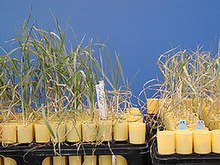
Crop alteration has been practiced by humankind for thousands of years, since the beginning of civilization. Altering crops through breeding practices changes the genetic make-up of a plant to develop crops with more beneficial characteristics for humans, for example, larger fruits or seeds, drought-tolerance, or resistance to pests. Significant advances in plant breeding ensued after the work of geneticistGregor Mendel.His work ondominantandrecessive alleles,although initially largely ignored for almost 50 years, gave plant breeders a better understanding of genetics and breeding techniques. Crop breeding includes techniques such as plant selection with desirable traits,self-pollinationandcross-pollination,and molecular techniques that genetically modify the organism.[179]
Domestication of plants has, over the centuries increased yield, improved disease resistance anddrought tolerance,eased harvest and improved the taste and nutritional value of crop plants. Careful selection and breeding have had enormous effects on the characteristics of crop plants. Plant selection and breeding in the 1920s and 1930s improved pasture (grasses and clover) in New Zealand. Extensive X-ray and ultraviolet induced mutagenesis efforts (i.e. primitive genetic engineering) during the 1950s produced the modern commercial varieties of grains such as wheat, corn (maize) and barley.[180][181]

TheGreen Revolutionpopularized the use of conventionalhybridizationto sharply increase yield by creating "high-yielding varieties". For example, average yields of corn (maize) in the US have increased from around 2.5 tons per hectare (t/ha) (40 bushels per acre) in 1900 to about 9.4 t/ha (150 bushels per acre) in 2001. Similarly, worldwide average wheat yields have increased from less than 1 t/ha in 1900 to more than 2.5 t/ha in 1990. South American average wheat yields are around 2 t/ha, African under 1 t/ha, and Egypt and Arabia up to 3.5 to 4 t/ha with irrigation. In contrast, the average wheat yield in countries such as France is over 8 t/ha. Variations in yields are due mainly to variation in climate, genetics, and the level of intensive farming techniques (use of fertilizers, chemical pest control, and growth control to avoid lodging).[182][183][184]
Genetic engineering

Genetically modified organisms (GMO) areorganismswhosegeneticmaterial has been altered by genetic engineering techniques generally known asrecombinant DNA technology.Genetic engineering has expanded the genes available to breeders to use in creating desired germlines for new crops. Increased durability, nutritional content, insect and virus resistance and herbicide tolerance are a few of the attributes bred into crops through genetic engineering.[185]For some, GMO crops causefood safetyandfood labelingconcerns. Numerous countries have placed restrictions on the production, import or use of GMO foods and crops.[186]TheBiosafety Protocol,an international treaty, regulates the trade of GMOs. There is ongoing discussion regarding the labeling of foods made from GMOs, and while the EU currently requires all GMO foods to be labeled, the US does not.[187]
Herbicide-resistant seeds have a gene implanted into their genome that allows the plants to tolerate exposure to herbicides, includingglyphosate.These seeds allow the farmer to grow a crop that can be sprayed with herbicides to control weeds without harming the resistant crop. Herbicide-tolerant crops are used by farmers worldwide.[188]With the increasing use of herbicide-tolerant crops, comes an increase in the use of glyphosate-based herbicide sprays. In some areas glyphosate resistant weeds have developed, causing farmers to switch to other herbicides.[189][190]Some studies also link widespread glyphosate usage to iron deficiencies in some crops, which is both a crop production and a nutritional quality concern, with potential economic and health implications.[191]
Other GMO crops used by growers include insect-resistant crops, which have a gene from the soil bacteriumBacillus thuringiensis(Bt), which produces a toxin specific to insects. These crops resist damage by insects.[192]Some believe that similar or better pest-resistance traits can be acquired through traditional breeding practices, and resistance to various pests can be gained through hybridization or cross-pollination with wild species. In some cases, wild species are the primary source of resistance traits; some tomato cultivars that have gained resistance to at least 19 diseases did so through crossing with wild populations of tomatoes.[193]
Environmental impact
Effects and costs

Agriculture is both a cause of and sensitive toenvironmental degradation,such asbiodiversity loss,desertification,soil degradationandclimate change,which cause decreases in crop yield.[194]Agriculture is one of the most important drivers of environmental pressures, particularly habitat change, climate change, water use and toxic emissions. Agriculture is the main source of toxins released into the environment, including insecticides, especially those used on cotton.[195][196][page needed]The 2011 UNEP Green Economy report stated that agricultural operations produced some 13 per cent of anthropogenic global greenhouse gas emissions. This includes gases from the use of inorganic fertilizers, agro-chemical pesticides, and herbicides, as well as fossil fuel-energy inputs.[197]
Agriculture imposes multiple external costs upon society through effects such as pesticide damage to nature (especially herbicides and insecticides), nutrient runoff, excessive water usage, and loss of natural environment. A 2000 assessment of agriculture in the UK determined total external costs for 1996 of £2,343 million, or £208 per hectare.[198]A 2005 analysis of these costs in the US concluded that cropland imposes approximately $5 to $16 billion ($30 to $96 per hectare), while livestock production imposes $714 million.[199]Both studies, which focused solely on the fiscal impacts, concluded that more should be done to internalize external costs. Neither included subsidies in their analysis, but they noted that subsidies also influence the cost of agriculture to society.[198][199]
Agriculture seeks to increase yield and to reduce costs, often employing measures that cut biodiversity to very low levels. Yield increases with inputs such as fertilisers and removal of pathogens, predators, and competitors (such as weeds). Costs decrease with increasing scale of farm units, such as making fields larger; this means removinghedges,ditches and other areas of habitat. Pesticides kill insects, plants and fungi. Effective yields fall with on-farm losses, which may be caused by poor production practices during harvesting, handling, and storage.[200]
The environmental effects of climate change show that research on pests and diseases that do not generally afflict areas is essential. In 2021, farmers discoveredstem ruston wheat in theChampagnearea of France, a disease that had previously only occurred inMoroccofor 20 to 30 years. Because of climate change, insects that used to die off over the winter are now alive and multiplying.[201][202]
Livestock issues
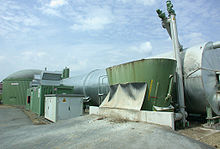
A senior UN official, Henning Steinfeld, said that "Livestock are one of the most significant contributors to today's most serious environmental problems".[203]Livestock production occupies 70% of all land used for agriculture, or 30% of the land surface of the planet. It is one of the largest sources ofgreenhouse gases,responsible for 18% of the world'sgreenhouse gas emissionsas measured in CO2equivalents. By comparison, all transportation emits 13.5% of the CO2.It produces 65% of human-relatednitrous oxide(which has 296 times theglobal warming potentialof CO2) and 37% of all human-inducedmethane(which is 23 times as warming as CO2.) It also generates 64% of theammoniaemission. Livestock expansion is cited as a key factor drivingdeforestation;in the Amazon basin 70% ofpreviously forested areais now occupied by pastures and the remainder used for feed crops.[204]Through deforestation andland degradation,livestock is also driving reductions in biodiversity. A well documented phenomenon iswoody plant encroachment,caused by overgrazing in rangelands.[205]Furthermore, theUnited Nations Environment Programme(UNEP) states that "methane emissionsfrom global livestock are projected to increase by 60 per cent by 2030 under current practices and consumption patterns. "[197]
Land and water issues
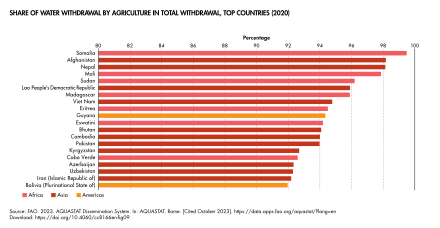
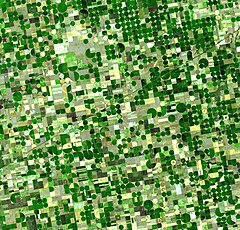
Land transformation, the use of land to yield goods and services, is the most substantial way humans alter the Earth's ecosystems, and is the driving force causingbiodiversity loss.Estimates of the amount of land transformed by humans vary from 39 to 50%.[206]It is estimated that 24% of land globally experiences land degradation, a long-term decline in ecosystem function and productivity, with cropland being disproportionately affected.[207]Land management is the driving factor behind degradation; 1.5 billion people rely upon the degrading land. Degradation can be through deforestation,desertification,soil erosion,mineral depletion,acidification,orsalinization.[144]In 2021, the global agricultural land area was 4.79 billion hectares (ha), down 2 percent, or 0.09 billion ha compared with 2000. Between 2000 and 2021, roughly two-thirds of agricultural land were used for permanent meadows and pastures (3.21 billion ha in 2021), which declined by 5 percent (0.17 billion ha). One-third of the total agricultural land was cropland (1.58 billion ha in 2021), which increased by 6 percent (0.09 billion ha).[108]
Eutrophication,excessive nutrient enrichment inaquatic ecosystemsresulting inalgal bloomsandanoxia,leads tofish kills,loss of biodiversity,and renders water unfit for drinking and other industrial uses. Excessive fertilization and manure application to cropland, as well as high livestock stocking densities cause nutrient (mainlynitrogenandphosphorus)runoffandleachingfrom agricultural land. These nutrients are majornonpoint pollutantscontributing toeutrophicationof aquatic ecosystems and pollution of groundwater, with harmful effects on human populations.[208]Fertilisers also reduce terrestrial biodiversity by increasing competition for light, favouring those species that are able to benefit from the added nutrients.[209]
Agriculture simultaneously is facing growing freshwater demand and precipitation anomalies (droughts, floods, and extreme rainfall and weather events) on rainfed areasfields and grazing lands.[162]Agriculture accounts for 70 percent of withdrawals of freshwater resources,[210][211]and an estimated 41 percent of current global irrigation water use occurs at the expense of environmental flow requirements.[162]It is long known that aquifers in areas as diverse as northern China, theUpper Gangesand the western US are being depleted, and new research extends these problems to aquifers in Iran, Mexico and Saudi Arabia.[212]Increasing pressure is being placed on water resources by industry and urban areas, meaning thatwater scarcityis increasing and agriculture is facing the challenge of producing more food for the world's growing population with reduced water resources.[213]While industrial withdrawals have declined in the past few decades and municipal withdrawals have increased only marginally since 2010, agricultural withdrawals have continued to grow at an ever faster pace.[162]Agricultural waterusage can also cause major environmental problems, including the destruction of natural wetlands, the spread of water-borne diseases, and land degradation through salinization and waterlogging, when irrigation is performed incorrectly.[214]
Pesticides

Pesticide use has increased since 1950 to 2.5 million short tons annually worldwide, yet crop loss from pests has remained relatively constant.[215]The World Health Organization estimated in 1992 that three million pesticide poisonings occur annually, causing 220,000 deaths.[216]Pesticides select forpesticide resistancein the pest population, leading to a condition termed the "pesticide treadmill" in which pest resistance warrants the development of a new pesticide.[217]
An alternative argument is that the way to "save the environment" and prevent famine is by using pesticides and intensive high yield farming, a view exemplified by a quote heading the Center for Global Food Issues website: 'Growing more per acre leaves more land for nature'.[218][219]However, critics argue that a trade-off between the environment and a need for food is not inevitable,[220]and that pesticides can replacegood agronomic practicessuch as crop rotation.[217]ThePush–pull agricultural pest managementtechnique involves intercropping, using plant aromas to repel pests from crops (push) and to lure them to a place from which they can then be removed (pull).[221]
Contribution to climate change

Agriculture contributes towardsclimate changethroughgreenhouse gas emissionsand by the conversion of non-agricultural land such asforestsinto agricultural land.[222]The agriculture, forestry and land use sector contribute between 13% and 21% of global greenhouse gas emissions.[223]Emissions ofnitrous oxide,methanemake up over half of total greenhouse gas emission from agriculture.[224]Animal husbandryis a major source of greenhouse gas emissions.[225]
Approximately 57% of global GHG emissions from the production of food are from the production of animal-based food while plant-based foods contribute 29% and the remaining 14% is for other utilizations.[226]Farmland management andland-use changerepresented major shares of total emissions (38% and 29%, respectively), whereas rice and beef were the largest contributing plant- and animal-based commodities (12% and 25%, respectively).[226]South and Southeast Asia and South America were the largest emitters of production-based GHGs.[226]
Sustainability
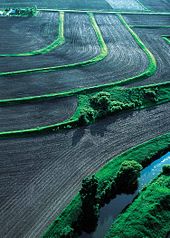
Current farming methods have resulted in over-stretched water resources, high levels of erosion and reduced soil fertility. There is not enough water to continue farming using current practices; therefore how water, land, andecosystemresources are used to boost crop yields must be reconsidered. A solution would be to give value to ecosystems, recognizing environmental and livelihood tradeoffs, and balancing the rights of a variety of users and interests.[227]Inequities that result when such measures are adopted would need to be addressed, such as the reallocation of water from poor to rich, the clearing of land to make way for more productive farmland, or the preservation of a wetland system that limits fishing rights.[228]
Technological advancements help provide farmers with tools and resources to make farming more sustainable.[229]Technology permits innovations likeconservation tillage,a farming process which helps prevent land loss to erosion, reduces water pollution, and enhancescarbon sequestration.[230]
Agricultural automation can help address some of the challenges associated with climate change and thus facilitate adaptation efforts.[160]For example, the application of digital automation technologies (e.g. in precision agriculture) can improve resource-use efficiency in conditions which are increasingly constrained for agricultural producers.[160]Moreover, when applied to sensing and early warning, they can help address the uncertainty and unpredictability of weather conditions associated with accelerating climate change.[160]
Other potential sustainable practices includeconservation agriculture,agroforestry,improvedgrazing,avoided grassland conversion, andbiochar.[231][232]Current mono-crop farming practices in the United States preclude widespread adoption of sustainable practices, such as 2–3 crop rotations that incorporate grass or hay with annual crops, unless negative emission goals such as soil carbon sequestration become policy.[233]
The food demand of Earth's projected population, with current climate change predictions, could be satisfied by improvement of agricultural methods, expansion of agricultural areas, and a sustainability-oriented consumer mindset.[234]
Energy dependence

Since the 1940s, agricultural productivity has increased dramatically, due largely to the increased use of energy-intensive mechanization, fertilizers and pesticides. The vast majority of this energy input comes fromfossil fuelsources.[235]Between the 1960s and the 1980s, the Green Revolution transformed agriculture around the globe, with world grain production increasing significantly (between 70% and 390% for wheat and 60% to 150% for rice, depending on geographic area)[236]asworld populationdoubled. Heavy reliance onpetrochemicalshas raised concerns that oil shortages could increase costs and reduce agricultural output.[237]
Industrialized agriculture depends onfossil fuelsin two fundamental ways: direct consumption on the farm and manufacture of inputs used on the farm. Direct consumption includes the use of lubricants and fuels to operate farm vehicles and machinery.[237]
Indirect consumption includes the manufacture of fertilizers, pesticides, and farm machinery.[237]In particular, the production ofnitrogen fertilizercan account for over half of agricultural energy usage.[238]Together, direct and indirect consumption by US farms accounts for about 2% of the nation's energy use. Direct and indirect energy consumption by U.S. farms peaked in 1979, and has since gradually declined.[237]Food systemsencompass not just agriculture but off-farm processing, packaging, transporting, marketing, consumption, and disposal of food and food-related items. Agriculture accounts for less than one-fifth of food system energy use in the US.[239][240]
Plastic pollution
Plastic products are used extensively in agriculture, including to increase crop yields and improve the efficiency of water and agrichemical use. "Agriplastic" products include films to covergreenhousesand tunnels, mulch to cover soil (e.g. to suppress weeds,conserve water,increase soil temperature and aid fertilizer application), shade cloth, pesticide containers, seedling trays, protective mesh and irrigation tubing. The polymers most commonly used in these products are low- density polyethylene (LPDE), linear low-density polyethylene (LLDPE), polypropylene (PP) and polyvinyl chloride (PVC).[241]
The total amount of plastics used in agriculture is difficult to quantify. A 2012 study reported that almost 6.5 million tonnes per year were consumed globally while a later study estimated that global demand in 2015 was between 7.3 million and 9 million tonnes. Widespread use of plastic mulch and lack of systematic collection and management have led to the generation of large amounts of mulch residue. Weathering and degradation eventually cause the mulch to fragment. These fragments and larger pieces of plastic accumulate in soil. Mulch residue has been measured at levels of 50 to 260 kg per hectare in topsoil in areas where mulch use dates back more than 10 years, which confirms that mulching is a major source of both microplastic and macroplastic soil contamination.[241]
Agricultural plastics, especially plastic films, are not easy to recycle because of high contamination levels (up to 40–50% by weight contamination by pesticides, fertilizers, soil and debris, moist vegetation, silage juice water, and UV stabilizers) and collection difficulties. Therefore, they are often buried or abandoned in fields and watercourses or burned. These disposal practices lead to soil degradation and can result in contamination of soils and leakage ofmicroplasticsinto the marine environment as a result of precipitation run-off and tidal washing. In addition, additives in residual plastic film (such as UV and thermal stabilizers) may have deleterious effects on crop growth, soil structure, nutrient transport and salt levels. There is a risk that plastic mulch will deterioratesoil quality,deplete soil organic matter stocks, increase soil water repellence and emit greenhouse gases. Microplastics released through fragmentation of agricultural plastics can absorb and concentrate contaminants capable of being passed up the trophic chain.[241]
Disciplines
Agricultural economics

Agricultural economics is economics as it relates to the "production, distribution and consumption of [agricultural] goods and services".[243]Combining agricultural production with general theories of marketing and business as a discipline of study began in the late 1800s, and grew significantly through the 20th century.[244]Although the study of agricultural economics is relatively recent, major trends in agriculture have significantly affected national and international economies throughout history, ranging fromtenant farmersandsharecroppingin the post-American Civil WarSouthern United States[245]to the Europeanfeudalsystem ofmanorialism.[246]In the United States, and elsewhere, food costs attributed tofood processing,distribution, andagricultural marketing,sometimes referred to as thevalue chain,have risen while the costs attributed to farming have declined. This is related to the greater efficiency of farming, combined with the increased level ofvalue addition(e.g. more highly processed products) provided by the supply chain.Market concentrationhas increased in the sector as well, and although the total effect of the increased market concentration is likely increased efficiency, the changes redistributeeconomic surplusfrom producers (farmers) and consumers, and may have negative implications for rural communities.[247]
National government policies, such as taxation,subsidies,tariffs and others, can significantly change the economic marketplace for agricultural products.[248]Since at least the 1960s, a combination of trade restrictions,exchange rate policiesand subsidies have affected farmers in both the developing and the developed world. In the 1980s, non-subsidized farmers in developing countries experienced adverse effects from national policies that created artificially low global prices for farm products. Between the mid-1980s and the early 2000s, several international agreements limited agricultural tariffs, subsidies and other trade restrictions.[249]
However, as of 2009[update],there was still a significant amount of policy-driven distortion in global agricultural product prices. The three agricultural products with the most trade distortion were sugar, milk and rice, mainly due to taxation. Among theoilseeds,sesame had the most taxation, but overall, feed grains and oilseeds had much lower levels of taxation than livestock products. Since the 1980s, policy-driven distortions have decreases more among livestock products than crops during the worldwide reforms in agricultural policy.[248]Despite this progress, certain crops, such as cotton, still see subsidies in developed countries artificially deflating global prices, causing hardship in developing countries with non-subsidized farmers.[250]Unprocessed commodities such as corn, soybeans, and cattle are generally graded to indicate quality, affecting the price the producer receives. Commodities are generally reported by production quantities, such as volume, number or weight.[251]
Agricultural science
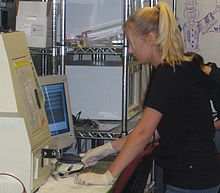
Agricultural scienceis a broad multidisciplinary field ofbiologythat encompasses the parts of exact, natural, economic andsocial sciencesused in the practice and understanding of agriculture. It covers topics such as agronomy, plant breeding and genetics,plant pathology,crop modelling, soil science,entomology,production techniques and improvement, study of pests and their management, and study of adverse environmental effects such as soil degradation,waste management,andbioremediation.[252][253]
The scientific study of agriculture began in the 18th century, whenJohann Friedrich Mayerconducted experiments on the use ofgypsum(hydratedcalcium sulphate) as a fertilizer.[254]Research became more systematic when in 1843,John Lawesand Henry Gilbert began a set of long-term agronomy field experiments atRothamsted Research Stationin England; some of them, such as thePark Grass Experiment,are still running.[255][256]In America, theHatch Act of 1887provided funding for what it was the first to call "agricultural science", driven by farmers' interest in fertilizers.[257]In agricultural entomology, the USDA began to research biological control in 1881; it instituted its first large program in 1905, searching Europe and Japan for natural enemies of thespongy mothandbrown-tailmoth, establishingparasitoids(such as solitary wasps) and predators of both pests in the US.[258][259][260]
Policy
| Product | Subsidy |
|---|---|
| Beef and veal | 18.0 |
| Milk | 15.3 |
| Pigs | 7.3 |
| Poultry | 6.5 |
| Soybeans | 2.3 |
| Eggs | 1.5 |
| Sheep | 1.1 |
Agricultural policyis the set of government decisions and actions relating to domestic agriculture and imports of foreign agricultural products. Governments usually implement agricultural policies with the goal of achieving a specific outcome in the domestic agricultural product markets. Some overarching themes include risk management and adjustment (including policies related to climate change, food safety and natural disasters),economic stability(including policies related to taxes), natural resources andenvironmental sustainability(especiallywater policy), research and development, and market access for domestic commodities (including relations with global organizations and agreements with other countries).[262]Agricultural policy can also touch onfood quality,ensuring that the food supply is of a consistent and known quality, food security, ensuring that the food supply meets the population's needs, andconservation.Policy programs can range from financial programs, such as subsidies, to encouraging producers to enroll in voluntary quality assurance programs.[263]
A 2021 report finds that globally, support to agricultural producers accounts for almost US$540 billion a year.[264]This amounts to 15 percent of total agricultural production value, and is heavily biased towards measures that are leading to inefficiency, as well as are unequally distributed and harmful for the environment and human health.[264]
There are many influences on the creation of agricultural policy, including consumers, agribusiness, trade lobbies and other groups.Agribusinessinterests hold a large amount of influence over policy making, in the form oflobbyingandcampaign contributions.Political action groups, including those interested in environmental issues and labor unions, also provide influence, as do lobbying organizations representing individual agricultural commodities.[265]TheFood and Agriculture Organization of the United Nations(FAO) leads international efforts to defeat hunger and provides a forum for the negotiation of global agricultural regulations and agreements. Samuel Jutzi, director of FAO's animal production and health division, states that lobbying by large corporations has stopped reforms that would improve human health and the environment. For example, proposals in 2010 for a voluntary code of conduct for the livestock industry that would have provided incentives for improving standards for health, and environmental regulations, such as the number of animals an area of land can support without long-term damage, were successfully defeated due to large food company pressure.[266]
See also
- Aeroponics
- Agricultural aircraft
- Agricultural engineering
- Agricultural machinery
- Agricultural robot
- Agroecology
- Agribusiness
- Agrominerals
- Building-integrated agriculture
- Contract farming
- Corporate farming
- Crofting
- Ecoagriculture
- Farmworker
- Food loss and waste
- Food security
- Hill farming
- List of documentary films about agriculture
- Pharming (genetics)
- Remote sensing
- Rural Development
- Soil biodiversity
- Subsistence economy
- Sustainable agriculture
- Urban agriculture
- Vertical farming
- Vegetable farming
References
- ^The State of Food and Agriculture 2021. Making agrifood systems more resilient to shocks and stresses.Rome: Food and Agriculture Organization of theUnited Nations.2021.doi:10.4060/cb4476en.ISBN978-92-5-134329-6.S2CID244548456.
- ^abcdLowder, Sarah K.; Sánchez, Marco V.; Bertini, Raffaele (1 June 2021)."Which farms feed the world and has farmland become more concentrated?".World Development.142:105455.doi:10.1016/j.worlddev.2021.105455.ISSN0305-750X.S2CID233553897.
- ^"FAOSTAT. New Food Balance Sheets".Food and Agriculture Organization.Retrieved12 July2021.
- ^"Discover Natural Fibres Initiative – DNFI.org".dnfi.org.Retrieved3 February2023.
- ^"FAOSTAT. Forestry Production and Trade".Food and Agriculture Organization.Retrieved12 July2021.
- ^In Brief: The State of Food and Agriculture 2019. Moving forward on food loss and waste reduction.Rome:Food and Agriculture Organization.2023.doi:10.4060/cc4140en.ISBN978-92-5-137588-4.
- ^Chantrell, Glynnis, ed. (2002).The Oxford Dictionary of Word Histories.Oxford University Press. p.14.ISBN978-0-19-863121-7.
- ^St. Fleur, Nicholas (6 October 2018)."An Ancient Ant-Bacteria Partnership to Protect Fungus".The New York Times.Archived fromthe originalon 1 January 2022.Retrieved14 July2020.
- ^Li, Hongjie; Sosa Calvo, Jeffrey; Horn, Heidi A.; Pupo, Mônica T.; Clardy, Jon; Rabeling, Cristian; Schultz, Ted R.; Currie, Cameron R. (2018)."Convergent evolution of complex structures for ant–bacterial defensive symbiosis in fungus-farming ants".Proceedings of the National Academy of Sciences of the United States of America.115(42): 10725.Bibcode:2018PNAS..11510720L.doi:10.1073/pnas.1809332115.PMC6196509.PMID30282739.
- ^Mueller, Ulrich G.;Gerardo, Nicole M.;Aanen, Duur K.;Six, Diana L.;Schultz, Ted R. (December 2005). "The Evolution of Agriculture in Insects".Annual Review of Ecology, Evolution, and Systematics.36:563–595.doi:10.1146/annurev.ecolsys.36.102003.152626.
- ^ab"Definition of Agriculture".State of Maine. Archived fromthe originalon 23 March 2012.Retrieved6 May2013.
- ^Stevenson, G. C. (1971). "Plant Agriculture Selected and introduced by Janick Jules and Others San Francisco: Freeman (1970), pp. 246, £2.10".Experimental Agriculture.7(4). Cambridge University Press (CUP): 363.doi:10.1017/s0014479700023371.ISSN0014-4797.S2CID85571333.
- ^Herren, R.V. (2012).Science of Animal Agriculture.Cengage Learning.ISBN978-1-133-41722-4.Archivedfrom the original on 31 May 2022.Retrieved1 May2022.
- ^abLarson, G.; Piperno, D. R.; Allaby, R. G.; Purugganan, M. D.; Andersson, L.; Arroyo-Kalin, M.; Barton, L.; Climer Vigueira, C.; Denham, T.; Dobney, K.; Doust, A. N.; Gepts, P.; Gilbert, M. T. P.; Gremillion, K. J.; Lucas, L.; Lukens, L.; Marshall, F. B.; Olsen, K. M.; Pires, J.C.; Richerson, P. J.; Rubio De Casas, R.; Sanjur, O.I.; Thomas, M. G.; Fuller, D.Q. (2014)."Current perspectives and the future of domestication studies".PNAS.111(17): 6139–6146.Bibcode:2014PNAS..111.6139L.doi:10.1073/pnas.1323964111.PMC4035915.PMID24757054.
- ^Denham, T. P. (2003)."Origins of Agriculture at Kuk Swamp in the Highlands of New Guinea".Science.301(5630): 189–193.doi:10.1126/science.1085255.PMID12817084.S2CID10644185.
- ^Bocquet-Appel, Jean-Pierre (29 July 2011). "When the World's Population Took Off: The Springboard of the Neolithic Demographic Transition".Science.333(6042): 560–561.Bibcode:2011Sci...333..560B.doi:10.1126/science.1208880.PMID21798934.S2CID29655920.
- ^Stephens, Lucas; Fuller, Dorian; Boivin, Nicole; Rick, Torben; Gauthier, Nicolas; Kay, Andrea; Marwick, Ben; Armstrong, Chelsey Geralda; Barton, C. Michael (30 August 2019). "Archaeological assessment reveals Earth's early transformation through land use".Science.365(6456): 897–902.Bibcode:2019Sci...365..897S.doi:10.1126/science.aax1192.hdl:10150/634688.ISSN0036-8075.PMID31467217.S2CID201674203.
- ^Harmon, Katherine (17 December 2009)."Humans feasting on grains for at least 100,000 years".Scientific American.Archivedfrom the original on 17 September 2016.Retrieved28 August2016.
- ^Snir, Ainit; Nadel, Dani; Groman-Yaroslavski, Iris; Melamed, Yoel; Sternberg, Marcelo; Bar-Yosef, Ofer; Weiss, Ehud (22 July 2015)."The Origin of Cultivation and Proto-Weeds, Long Before Neolithic Farming".PLOS ONE.10(7): e0131422.Bibcode:2015PLoSO..1031422S.doi:10.1371/journal.pone.0131422.ISSN1932-6203.PMC4511808.PMID26200895.
- ^"First evidence of farming in Mideast 23,000 years ago: Evidence of earliest small-scale agricultural cultivation".ScienceDaily.Archivedfrom the original on 23 April 2022.Retrieved23 April2022.
- ^Zong, Y.; When, Z.; Innes, J. B.; Chen, C.; Wang, Z.; Wang, H. (2007). "Fire and flood management of coastal swamp enabled first rice paddy cultivation in east China".Nature.449(7161): 459–462.Bibcode:2007Natur.449..459Z.doi:10.1038/nature06135.PMID17898767.S2CID4426729.
- ^Ensminger, M. E.; Parker, R. O. (1986).Sheep and Goat Science(Fifth ed.). Interstate Printers and Publishers.ISBN978-0-8134-2464-4.
- ^McTavish, E. J.; Decker, J. E.; Schnabel, R.D.; Taylor, J. F.; Hillis, D. M. (2013)."New World cattle show ancestry from multiple independent domestication events".PNAS.110(15): E1398–1406.Bibcode:2013PNAS..110E1398M.doi:10.1073/pnas.1303367110.PMC3625352.PMID23530234.
- ^Larson, Greger;Dobney, Keith;Albarella, Umberto; Fang, Meiying; Matisoo-Smith, Elizabeth; Robins, Judith; Lowden, Stewart; Finlayson, Heather; Brand, Tina (11 March 2005). "Worldwide Phylogeography of Wild Boar Reveals Multiple Centers of Pig Domestication".Science.307(5715): 1618–1621.Bibcode:2005Sci...307.1618L.doi:10.1126/science.1106927.PMID15761152.S2CID39923483.
- ^Larson, Greger; Albarella, Umberto; Dobney, Keith; Rowley-Conwy, Peter; Schibler, Jörg; Tresset, Anne; Vigne, Jean-Denis; Edwards, Ceiridwen J.; Schlumbaum, Angela (25 September 2007)."Ancient DNA, pig domestication, and the spread of the Neolithic into Europe".PNAS.104(39): 15276–15281.Bibcode:2007PNAS..10415276L.doi:10.1073/pnas.0703411104.PMC1976408.PMID17855556.
- ^Broudy, Eric (1979).The Book of Looms: A History of the Handloom from Ancient Times to the Present.UPNE. p. 81.ISBN978-0-87451-649-4.Archivedfrom the original on 10 February 2018.Retrieved10 February2019.
- ^"The Evolution of Corn".University of UtahHEALTH SCIENCES.Retrieved2 January2016.
- ^Benz, B. F. (2001)."Archaeological evidence of teosinte domestication from Guilá Naquitz, Oaxaca".Proceedings of the National Academy of Sciences.98(4): 2104–2106.Bibcode:2001PNAS...98.2104B.doi:10.1073/pnas.98.4.2104.PMC29389.PMID11172083.
- ^Johannessen, S.; Hastorf, C. A. (eds.)Corn and Culture in the Prehistoric New World,Westview Press, Boulder, Colorado.
- ^Dance, Amber (4 May 2022)."The tale of the domesticated horse".Knowable Magazine.doi:10.1146/knowable-050422-1.
- ^Hillman, G. C. (1996) "Late Pleistocene changes in wild plant-foods available to hunter-gatherers of the northern Fertile Crescent: Possible preludes to cereal cultivation". In D. R. Harris (ed.)The Origins and Spread of Agriculture and Pastoralism in Eurasia,UCL Books, London, pp. 159–203.ISBN9781857285383
- ^Sato, Y. (2003) "Origin of rice cultivation in the Yangtze River basin". In Y. Yasuda (ed.)The Origins of Pottery and Agriculture,Roli Books, New Delhi, p. 196
- ^abGerritsen, R. (2008). "Australia and the Origins of Agriculture".Encyclopedia of Global Archaeology.Archaeopress. pp. 29–30.doi:10.1007/978-1-4419-0465-2_1896.ISBN978-1-4073-0354-3.S2CID129339276.
- ^Diamond, J.;Bellwood, P. (2003). "Farmers and Their Languages: The First Expansions".Science.300(5619): 597–603.Bibcode:2003Sci...300..597D.CiteSeerX10.1.1.1013.4523.doi:10.1126/science.1078208.PMID12714734.S2CID13350469.
- ^"When the First Farmers Arrived in Europe, Inequality Evolved".Scientific American.1 July 2020.
- ^"Farming".British Museum.Archived fromthe originalon 16 June 2016.Retrieved15 June2016.
- ^Janick, Jules."Ancient Egyptian Agriculture and the Origins of Horticulture"(PDF).Acta Hort.583:23–39.Archived(PDF)from the original on 25 May 2013.Retrieved1 April2018.
- ^Kees, Herman (1961).Ancient Egypt: A Cultural Topography.University of Chicago Press.ISBN978-0226429144.
- ^Gupta, Anil K. (2004)."Origin of agriculture and domestication of plants and animals linked to early Holocene climate amelioration"(PDF).Current Science.87(1): 59.JSTOR24107979.Archived(PDF)from the original on 20 January 2019.Retrieved23 April2019.
- ^Baber, Zaheer (1996).The Science of Empire: Scientific Knowledge, Civilization, and Colonial Rule in India.State University of New York Press. 19.ISBN0-7914-2919-9.
- ^Harris, David R. and Gosden, C. (1996).The Origins and Spread of Agriculture and Pastoralism in Eurasia: Crops, Fields, Flocks And Herds.Routledge. p. 385.ISBN1-85728-538-7.
- ^Possehl, Gregory L. (1996).MehrgarhinOxford Companion to Archaeology,Ed. Brian Fagan. Oxford University Press.
- ^Stein, Burton (1998).A History of India.Blackwell Publishing. p. 47.ISBN0-631-20546-2.
- ^Lal, R. (2001). "Thematic evolution of ISTRO: transition in scientific issues and research focus from 1955 to 2000".Soil and Tillage Research.61(1–2): 3–12.Bibcode:2001STilR..61....3L.doi:10.1016/S0167-1987(01)00184-2.
- ^Needham,Vol. 6, Part 2, pp. 55–57.
- ^Needham,Vol. 4, Part 2, pp. 89, 110, 184.
- ^Needham,Vol. 4, Part 2, p. 110.
- ^Greenberger, Robert (2006)The Technology of Ancient China,Rosen Publishing Group. pp. 11–12.ISBN1404205586
- ^Wang Zhongshu,trans. by K. C. Chang and Collaborators,Han Civilization(New Haven and London: Yale University Press, 1982).
- ^Glick, Thomas F. (2005).Medieval Science, Technology And Medicine: An Encyclopedia.Volume 11 of The Routledge Encyclopedias of the Middle Ages Series. Psychology Press. p. 270.ISBN978-0-415-96930-7.
- ^Molina, J.; Sikora, M.; Garud, N.; Flowers, J. M.; Rubinstein, S.; Reynolds, A.; Huang, P.; Jackson, S.; Schaal, B. A.; Bustamante, C. D.; Boyko, A. R.; Purugganan, M. D. (2011)."Molecular evidence for a single evolutionary origin of domesticated rice".Proceedings of the National Academy of Sciences.108(20): 8351–8356.Bibcode:2011PNAS..108.8351M.doi:10.1073/pnas.1104686108.PMC3101000.PMID21536870.
- ^Huang, Xuehui; Kurata, Nori; Wei, Xinghua; Wang, Zi-Xuan; Wang, Ahong; Zhao, Qiang; Zhao, Yan; Liu, Kunyan; et al. (2012)."A map of rice genome variation reveals the origin of cultivated rice".Nature.490(7421): 497–501.Bibcode:2012Natur.490..497H.doi:10.1038/nature11532.PMC7518720.PMID23034647.
- ^Koester, Helmut (1995),History, Culture, and Religion of the Hellenistic Age,2nd edition, Walter de Gruyter, pp. 76–77.ISBN3-11-014693-2
- ^White, K. D. (1970),Roman Farming.Cornell University Press.
- ^abMurphy, Denis (2011).Plants, Biotechnology and Agriculture.CABI. p. 153.ISBN978-1-84593-913-7.
- ^Davis, Nicola (29 October 2018)."Origin of chocolate shifts 1,400 miles and 1,500 years".The Guardian.Archivedfrom the original on 30 October 2018.Retrieved31 October2018.
- ^Speller, Camilla F.;et al. (2010)."Ancient mitochondrial DNA analysis reveals complexity of indigenous North American turkey domestication".PNAS.107(7): 2807–2812.Bibcode:2010PNAS..107.2807S.doi:10.1073/pnas.0909724107.PMC2840336.PMID20133614.
- ^Mascarelli, Amanda (5 November 2010)."Mayans converted wetlands to farmland".Nature.doi:10.1038/news.2010.587.Archivedfrom the original on 23 April 2021.Retrieved17 May2013.
- ^Morgan, John (6 November 2013). "Invisible Artifacts: Uncovering Secrets of Ancient Maya Agriculture with Modern Soil Science".Soil Horizons.53(6): 3.doi:10.2136/sh2012-53-6-lf(inactive 24 April 2024).
{{cite journal}}:CS1 maint: DOI inactive as of April 2024 (link) - ^Spooner, David M.; McLean, Karen; Ramsay, Gavin; Waugh, Robbie; Bryan, Glenn J. (2005)."A single domestication for potato based on multilocus amplified fragment length polymorphism genotyping".PNAS.102(41): 14694–14699.Bibcode:2005PNAS..10214694S.doi:10.1073/pnas.0507400102.PMC1253605.PMID16203994.
- ^Office of International Affairs (1989).Lost Crops of the Incas: Little-Known Plants of the Andes with Promise for Worldwide Cultivation.p. 92.doi:10.17226/1398.ISBN978-0-309-04264-2.Archivedfrom the original on 2 December 2012.Retrieved1 April2018– via National Academies.org.
- ^Francis, John Michael (2005).Iberia and the Americas.ABC-CLIO.ISBN978-1-85109-426-4.
- ^Piperno, Dolores R. (2011)."The Origin of Plant Cultivation and Domestication in the New World Tropics: Pattern, Process, and New Developments".Current Anthropology.52(S-4): S453–S470.doi:10.1086/659998.S2CID83061925.
- ^Broudy, Eric (1979).The Book of Looms: A History of the Handloom from Ancient Times to the Present.UPNE. p. 81.ISBN978-0-87451-649-4.
- ^Rischkowsky, Barbara; Pilling, Dafydd (2007).The State of the World's Animal Genetic Resources for Food and Agriculture.Food & Agriculture Organization. p. 10.ISBN978-92-5-105762-9.
- ^Heiser, Carl B. Jr. (1992). "On possible sources of the tobacco of prehistoric Eastern North America".Current Anthropology.33:54–56.doi:10.1086/204032.S2CID144433864.
- ^Ford, Richard I. (1985).Prehistoric Food Production in North América.University of Michigan, Museum of Anthropology, Publications Department. p. 75.ISBN978-0-915703-01-2.Archivedfrom the original on 9 March 2020.Retrieved23 April2019.
- ^Adair, Mary J. (1988)Prehistoric Agriculture in the Central Plains.Publications in Anthropology 16. University of Kansas, Lawrence.
- ^Smith, Andrew (2013).The Oxford Encyclopedia of Food and Drink in America.OUP US. p. 1.ISBN978-0-19-973496-2.
- ^Hardigan, Michael A."P0653: Domestication History of Strawberry: Population Bottlenecks and Restructuring of Genetic Diversity through Time".Pland & Animal Genome Conference XXVI 13–17 January 2018 San Diego, California.Archivedfrom the original on 1 March 2018.Retrieved28 February2018.
- ^Sugihara, Neil G.; Van Wagtendonk, Jan W.; Shaffer, Kevin E.; Fites-Kaufman, Joann; Thode, Andrea E., eds. (2006). "17".Fire in California's Ecosystems.University of California Press. p.417.ISBN978-0-520-24605-8.
- ^Blackburn, Thomas C.; Anderson, Kat, eds. (1993).Before the Wilderness: Environmental Management by Native Californians.Ballena Press.ISBN978-0-87919-126-9.
- ^Cunningham, Laura (2010).State of Change: Forgotten Landscapes of California.Heyday. pp. 135, 173–202.ISBN978-1-59714-136-9.
- ^Anderson, M. Kat (2006).Tending the Wild: Native American Knowledge And the Management of California's Natural Resources.University of California Press.ISBN978-0-520-24851-9.
- ^Wilson, Gilbert (1917).Agriculture of the Hidatsa Indians: An Indian Interpretation.Dodo Press. pp. 25 and passim.ISBN978-1-4099-4233-7.Archived fromthe originalon 14 March 2016.
- ^Landon, Amanda J. (2008)."The" How "of the Three Sisters: The Origins of Agriculture in Mesoamerica and the Human Niche".Nebraska Anthropologist:110–124.Archivedfrom the original on 21 September 2013.Retrieved1 April2018.
- ^Jones, R. (2012)."Fire-stick Farming".Fire Ecology.8(3): 3–8.Bibcode:2012FiEco...8c...3J.doi:10.1007/BF03400623.
- ^Rowley-Conwy, Peter; Layton, Robert (27 March 2011)."Foraging and farming as niche construction: stable and unstable adaptations".Philosophical Transactions of the Royal Society B: Biological Sciences.366(1566): 849–862.doi:10.1098/rstb.2010.0307.ISSN0962-8436.PMC3048996.PMID21320899.
- ^Williams, Elizabeth (1988). "Complex Hunter-Gatherers: A Late Holocene Example from Temperate Australia".Archaeopress Archaeology.423.
- ^Lourandos, Harry (1997).Continent of Hunter-Gatherers: New Perspectives in Australian Prehistory.Cambridge University Press.
- ^Gammage, Bill(October 2011).The Biggest Estate on Earth: How Aborigines made Australia.Allen & Unwin. pp. 281–304.ISBN978-1-74237-748-3.
- ^National Geographic (2015).Food Journeys of a Lifetime.National Geographic Society.p. 126.ISBN978-1-4262-1609-1.
- ^Watson, Andrew M. (1974). "The Arab Agricultural Revolution and Its Diffusion, 700–1100".The Journal of Economic History.34(1): 8–35.doi:10.1017/s0022050700079602.S2CID154359726.
- ^Crosby, Alfred."The Columbian Exchange".The Gilder Lehrman Institute of American History.Archivedfrom the original on 3 July 2013.Retrieved11 May2013.
- ^Janick, Jules."Agricultural Scientific Revolution: Mechanical"(PDF).Purdue University.Archived(PDF)from the original on 25 May 2013.Retrieved24 May2013.
- ^Reid, John F. (2011)."The Impact of Mechanization on Agriculture".The Bridge on Agriculture and Information Technology.41(3).Archivedfrom the original on 5 November 2013.
- ^abPhilpott, Tom (19 April 2013)."A Brief History of Our Deadly Addiction to Nitrogen Fertilizer".Mother Jones.Archivedfrom the original on 5 May 2013.Retrieved7 May2013.
- ^"Ten worst famines of the 20th century".Sydney Morning Herald.15 August 2011.Archivedfrom the original on 3 July 2014.
- ^Hobbs, Peter R; Sayre, Ken; Gupta, Raj (12 February 2008)."The role of conservation agriculture in sustainable agriculture".Philosophical Transactions of the Royal Society B: Biological Sciences.363(1491): 543–555.doi:10.1098/rstb.2007.2169.PMC2610169.PMID17720669.
- ^Blench, Roger (2001).Pastoralists in the new millennium(PDF).FAO. pp. 11–12.Archived(PDF)from the original on 1 February 2012.
- ^"Shifting cultivation".Survival International.Archivedfrom the original on 29 August 2016.Retrieved28 August2016.
- ^Waters, Tony (2007).The Persistence of Subsistence Agriculture: life beneath the level of the marketplace.Le xing ton Books.
- ^"Chinese project offers a brighter farming future".Editorial.Nature.555(7695): 141. 7 March 2018.Bibcode:2018Natur.555R.141..doi:10.1038/d41586-018-02742-3.PMID29517037.
- ^"Encyclopædia Britannica's definition of Intensive Agriculture".Archived fromthe originalon 5 July 2006.
- ^"BBC School fact sheet on intensive farming".Archived fromthe originalon 3 May 2007.
- ^"Wheat Stem Rust – UG99 (Race TTKSK)".FAO.Archivedfrom the original on 7 January 2014.Retrieved6 January2014.
- ^Sample, Ian (31 August 2007)."Global food crisis looms as climate change and population growth strip fertile land"Archived29 April 2016 at theWayback Machine,The Guardian(London).
- ^"Africa may be able to feed only 25% of its population by 2025".Mongabay.14 December 2006. Archived fromthe originalon 27 November 2011.Retrieved15 July2016.
- ^Scheierling, Susanne M. (1995)."Overcoming agricultural pollution of water: the challenge of integrating agricultural and environmental policies in the European Union, Volume 1".The World Bank. Archived fromthe originalon 5 June 2013.Retrieved15 April2013.
- ^"CAP Reform".European Commission. 2003.Archivedfrom the original on 17 October 2010.Retrieved15 April2013.
- ^Poincelot, Raymond P. (1986). "Organic Farming".Toward a More Sustainable Agriculture.pp. 14–32.doi:10.1007/978-1-4684-1506-3_2.ISBN978-1-4684-1508-7.
- ^"The cutting-edge technology that will change farming".Agweek.9 November 2018. Archived fromthe originalon 17 November 2018.Retrieved23 November2018.
- ^Charles, Dan (3 November 2017)."Hydroponic Veggies Are Taking Over Organic, And A Move To Ban Them Fails".NPR.Archivedfrom the original on 24 November 2018.Retrieved24 November2018.
- ^Knapp, Samuel; van der Heijden, Marcel G. A. (7 September 2018)."A global meta-analysis of yield stability in organic and conservation agriculture".Nature Communications.9(1): 3632.Bibcode:2018NatCo...9.3632K.doi:10.1038/s41467-018-05956-1.ISSN2041-1723.PMC6128901.PMID30194344.
- ^GM Science Review First ReportArchived16 October 2013 at theWayback Machine,Prepared by the UK GM Science Review panel (July 2003). Chairman David King, p. 9
- ^ab"UNCTADstat – Table view".Archivedfrom the original on 20 October 2017.Retrieved26 November2017.
- ^"Agricultural Productivity in the United States".USDA Economic Research Service. 5 July 2012. Archived fromthe originalon 1 February 2013.Retrieved22 April2013.
- ^abcWorld Food and Agriculture – Statistical Yearbook 2023.FAO.2023.doi:10.4060/cc8166en.ISBN978-92-5-138262-2.Retrieved13 December2023– via FAODocuments.
- ^abcThe State of Food Security and Nutrition in the World 2022. Repurposing food and agricultural policies to make healthy diets more affordable.Rome: Food and Agriculture Organization of the United Nations. 2022.doi:10.4060/cc0639en.hdl:10654/44801.ISBN978-92-5-136499-4.S2CID264474106.
- ^In Brief to The State of Food Security and Nutrition in the World 2022. Repurposing food and agricultural policies to make healthy diets more affordable.Rome: Food and Agriculture Organization of the United Nations. 2022.doi:10.4060/cc0640en.ISBN978-92-5-136502-1.
- ^"Food prices: smallholder farmers can be part of the solution".International Fund for Agricultural Development. Archived fromthe originalon 5 May 2013.Retrieved24 April2013.
- ^"World Bank. 2021. Employment in agriculture (% of total employment) (modeled ILO estimate)".The World Bank.Washington, DC. 2021.Retrieved12 May2021.
- ^Michaels, Guy; Rauch, Ferdinand; Redding, Stephen J. (2012)."Urbanization and Structural Transformation".The Quarterly Journal of Economics.127(2): 535–586.doi:10.1093/qje/qjs003.ISSN0033-5533.JSTOR23251993.
- ^Gollin, Douglas; Parente, Stephen; Rogerson, Richard (2002)."The Role of Agriculture in Development".The American Economic Review.92(2): 160–164.doi:10.1257/000282802320189177.ISSN0002-8282.JSTOR3083394.
- ^Lewis, W. Arthur (1954)."Economic Development with Unlimited Supplies of Labour".The Manchester School.22(2): 139–191.doi:10.1111/j.1467-9957.1954.tb00021.x.ISSN1463-6786.
- ^"FAOSTAT: Employment Indicators: Agriculture".FAO.Rome. 2022.Retrieved6 February2022.
- ^"Employment in agriculture (% of total employment) (modeled ILO estimate) | Data".data.worldbank.org.Retrieved14 March2023.
- ^Allen, Robert C."Economic structure and agricultural productivity in Europe, 1300–1800"(PDF).European Review of Economic History.3:1–25. Archived fromthe original(PDF)on 27 October 2014.
- ^"Labor Force – By Occupation".The World Factbook.Central Intelligence Agency. Archived fromthe originalon 22 May 2014.Retrieved4 May2013.
- ^abc"Safety and health in agriculture".International Labour Organization.21 March 2011.Archivedfrom the original on 18 March 2018.Retrieved1 April2018.
- ^"Services sector overtakes farming as world's biggest employer: ILO".The Financial Express.Associated Press. 26 January 2007.Archivedfrom the original on 13 October 2013.Retrieved24 April2013.
- ^In Brief: The State of Food and Agriculture 2018. Migration, agriculture and rural development.Rome: FAO. 2018.
- ^Caruso, F.; Corrado, A. (2015). "Migrazioni e lavoro agricolo: un confronto tra Italia e Spagna in tempi di crisi". In M. Colucci & S. Gallo (ed.).Tempo di cambiare. Rapporto 2015 sulle migrazioni interne in Italia.Rome: Donizelli. pp. 58–77.
- ^Kasimis, Charalambos (1 October 2005)."Migrants in the Rural Economies of Greece and Southern Europe".migrationpolicy.org.Retrieved6 February2023.
- ^Nori, M. (2017).The shades of green: Migrants' contribution to EU agriculture. Context, trends, opportunities, challenges.Florence: Migration Policy Centre.doi:10.2870/785454.hdl:1814/49004.ISBN9789290845560.ISSN2467-4540.
- ^Fonseca, Maria Lucinda (November 2008)."New waves of immigration to small towns and rural areas in Portugal: Immigration to Rural Portugal".Population, Space and Place.14(6): 525–535.doi:10.1002/psp.514.
- ^Preibisch, Kerry (2010)."Pick-Your-Own Labor: Migrant Workers and Flexibility in Canadian Agriculture".The International Migration Review.44(2): 404–441.doi:10.1111/j.1747-7379.2010.00811.x.ISSN0197-9183.JSTOR25740855.S2CID145604068.
- ^"Agriculture: How immigration plays a critical role".New American Economy.Retrieved6 February2023.
- ^abcdThe State of Food and Agriculture 2017. Leveraging food systems for inclusive rural transformation.Rome: FAO. 2017.ISBN978-92-5-109873-8.
- ^abcdThe status of women in agrifood systems - Overview.Rome: FAO. 2023.doi:10.4060/cc5060en.S2CID258145984.
- ^"NIOSH Workplace Safety & Health Topic: Agricultural Injuries".Centers for Disease Control and Prevention.Archivedfrom the original on 28 October 2007.Retrieved16 April2013.
- ^"NIOSH Pesticide Poisoning Monitoring Program Protects Farmworkers".Centers for Disease Control and Prevention.2011.doi:10.26616/NIOSHPUB2012108.Archivedfrom the original on 2 April 2013.Retrieved15 April2013.
- ^ab"NIOSH Workplace Safety & Health Topic: Agriculture".Centers for Disease Control and Prevention.Archivedfrom the original on 9 October 2007.Retrieved16 April2013.
- ^abWeichelt, Bryan; Gorucu, Serap (17 February 2018)."Supplemental surveillance: a review of 2015 and 2016 agricultural injury data from news reports on AgInjuryNews.org".Injury Prevention.25(3): injuryprev–2017–042671.doi:10.1136/injuryprev-2017-042671.PMID29386372.S2CID3371442.Archivedfrom the original on 27 April 2018.Retrieved18 April2018.
- ^The PLOS ONE staff (6 September 2018)."Correction: Towards a deeper understanding of parenting on farms: A qualitative study".PLOS ONE.13(9): e0203842.Bibcode:2018PLoSO..1303842..doi:10.1371/journal.pone.0203842.ISSN1932-6203.PMC6126865.PMID30188948.
- ^"Agriculture: A hazardous work".International Labour Organization.15 June 2009.Archivedfrom the original on 3 March 2018.Retrieved1 April2018.
- ^"CDC – NIOSH – NORA Agriculture, Forestry and Fishing Sector Council".NIOSH.21 March 2018.Archivedfrom the original on 18 June 2019.Retrieved7 April2018.
- ^"CDC – NIOSH Program Portfolio: Agriculture, Forestry and Fishing: Program Description".NIOSH.28 February 2018.Archivedfrom the original on 8 April 2018.Retrieved7 April2018.
- ^"Protecting health and safety of workers in agriculture, livestock farming, horticulture and forestry".European Agency for Safety and Health at Work.17 August 2017.Archivedfrom the original on 29 September 2018.Retrieved10 April2018.
- ^Heiberger, Scott (3 July 2018). "The future of agricultural safety and health: North American Agricultural Safety Summit, February 2018, Scottsdale, Arizona".Journal of Agromedicine.23(3): 302–304.doi:10.1080/1059924X.2018.1485089.ISSN1059-924X.PMID30047853.S2CID51721534.
- ^"Value of agricultural production".Our World in Data.Archivedfrom the original on 8 March 2020.Retrieved6 March2020.
- ^"Analysis of farming systems".Food and Agriculture Organization.Archivedfrom the original on 6 August 2013.Retrieved22 May2013.
- ^ab"Agricultural Production Systems". pp. 283–317 inAcquaah.
- ^abcdefg"Farming Systems: Development, Productivity, and Sustainability", pp. 25–57 inChrispeels
- ^abcd"Food and Agriculture Organization of the United Nations (FAOSTAT)".Archived fromthe originalon 18 January 2013.Retrieved2 February2013.
- ^"Profiles of 15 of the world's major plant and animal fibres".FAO. 2009.Archivedfrom the original on 3 December 2020.Retrieved26 March2018.
- ^Clutton-Brock, Juliet (1999).A Natural History of Domesticated Mammals.Cambridge University Press. pp. 1–2.ISBN978-0-521-63495-3.
- ^Falvey, John Lindsay(1985).Introduction to Working Animals.Melbourne, Australia: MPW Australia.ISBN978-1-86252-992-2.
- ^abcSere, C.; Steinfeld, H.; Groeneweld, J. (1995)."Description of Systems in World Livestock Systems – Current status issues and trends".U.N. Food and Agriculture Organization.Archivedfrom the original on 26 October 2012.Retrieved8 September2013.
- ^abThornton, Philip K. (27 September 2010)."Livestock production: recent trends, future prospects".Philosophical Transactions of the Royal Society B.365(1554): 2853–2867.doi:10.1098/rstb.2010.0134.PMC2935116.PMID20713389.
- ^Stier, Ken (19 September 2007)."Fish Farming's Growing Dangers".Time.Archivedfrom the original on 7 September 2013.
- ^Ajmone-Marsan, P. (May 2010)."A global view of livestock biodiversity and conservation – Globaldiv".Animal Genetics.41(supplement S1): 1–5.doi:10.1111/j.1365-2052.2010.02036.x.PMID20500752.Archivedfrom the original on 3 August 2017.
- ^"Growth Promoting Hormones Pose Health Risk to Consumers, Confirms EU Scientific Committee"(PDF).European Union. 23 April 2002.Archived(PDF)from the original on 2 May 2013.Retrieved6 April2013.
- ^abBrady, N. C.; Weil, R. R. (2002). "Practical Nutrient Management" pp. 472–515 inElements of the Nature and Properties of Soils.Pearson Prentice Hall, Upper Saddle River, NJ.ISBN978-0135051955
- ^"Land Preparation and Farm Energy", pp. 318–338 inAcquaah
- ^"Pesticide Use in U.S. Crop Production", pp. 240–282 inAcquaah
- ^"Soil and Land", pp. 165–210 inAcquaah
- ^"Nutrition from the Soil", pp. 187–218 inChrispeels
- ^"Plants and Soil Water", pp. 211–239 inAcquaah
- ^abcdefghijThe State of Food and Agriculture 2022. Leveraging agricultural automation for transforming agrifood systems.Rome: FAO. 2022.doi:10.4060/cb9479en.ISBN978-92-5-136043-9.
- ^Pimentel, D.; Berger, D.; Filberto, D.; Newton, M. (2004)."Water Resources: Agricultural and Environmental Issues".BioScience.54(10): 909–918.doi:10.1641/0006-3568(2004)054[0909:WRAAEI]2.0.CO;2.
- ^abcdThe State of Food and Agriculture 2020. Overcoming water challenges in agriculture.Rome: FAO. 2020.doi:10.4060/cb1447en.ISBN978-92-5-133441-6.S2CID241788672.
- ^Rosegrant, Mark W.; Koo, Jawoo; Cenacchi, Nicola; Ringler, Claudia; Robertson, Richard D.; Fisher, Myles; Cox, Cindy M.; Garrett, Karen; Perez, Nicostrato D.; Sabbagh, Pascale (2014).Food Security in a World of Natural Resource Scarcity.International Food Policy Research Institute.doi:10.2499/9780896298477.Archivedfrom the original on 5 March 2014.
- ^Tacconi, L. (2012). "Redefining payments for environmental services".Ecological Economics.73(1): 29–36.Bibcode:2012EcoEc..73...29T.doi:10.1016/j.ecolecon.2011.09.028.
- ^Gan, H.; Lee, W. S. (1 January 2018)."Development of a Navigation System for a Smart Farm".IFAC-PapersOnLine.6th IFAC Conference on Bio-Robotics BIOROBOTICS 2018.51(17): 1–4.doi:10.1016/j.ifacol.2018.08.051.ISSN2405-8963.
- ^Lowenberg-DeBoer, James; Huang, Iona Yuelu; Grigoriadis, Vasileios; Blackmore, Simon (1 April 2020)."Economics of robots and automation in field crop production".Precision Agriculture.21(2): 278–299.doi:10.1007/s11119-019-09667-5.ISSN1573-1618.S2CID254932536.
- ^abcdIn Brief to The State of Food and Agriculture 2022. Leveraging automation in agriculture for transforming agrifood systems.Rome: FAO. 2022.doi:10.4060/cc2459en.ISBN978-92-5-137005-6.
- ^abcSantos Valle, S.; Kienzle, J. (2020).Agriculture 4.0 – Agricultural robotics and automated equipment for sustainable crop production.FAO.
- ^"FAOSTAT: Discontinued archives and data series: Machinery".Food and Agriculture Organization.Retrieved1 December2021.
- ^Daum, Thomas; Birner, Regina (1 September 2020)."Agricultural mechanization in Africa: Myths, realities and an emerging research agenda".Global Food Security.26:100393.Bibcode:2020GlFS...2600393D.doi:10.1016/j.gfs.2020.100393.ISSN2211-9124.S2CID225280050.
- ^Rodenburg, Jack (2017)."Robotic milking: Technology, farm design, and effects on work flow".Journal of Dairy Science.100(9): 7729–7738.doi:10.3168/jds.2016-11715.ISSN0022-0302.PMID28711263.S2CID11934286.Archivedfrom the original on 13 April 2023.
- ^Lowenberg-DeBoer, J. (2022).Economics of adoption for digital automated technologies in agriculture. Background paper for The State of Food and Agriculture 2022.Rome: FAO.doi:10.4060/cc2624en.ISBN978-92-5-137080-3.
- ^abcEnabling inclusive agricultural automation.Rome: FAO. 2022.doi:10.4060/cc2688en.ISBN978-92-5-137099-5.
- ^Milius, Susan (13 December 2017)."Worries grow that climate change will quietly steal nutrients from major food crops".Science News.Archivedfrom the original on 23 April 2019.Retrieved21 January2018.
- ^Hoffmann, U., Section B: Agriculture – a key driver and a major victim of global warming, in: Lead Article, in: Chapter 1, inHoffmann, U., ed. (2013).Trade and Environment Review 2013: Wake up before it is too late: Make agriculture truly sustainable now for food security in a changing climate.Geneva, Switzerland: United Nations Conference on Trade and Development (UNCTAD). pp. 3, 5. Archived fromthe originalon 28 November 2014.
- ^Porter, J. R.,et al.., Executive summary, in:Chapter 7: Food security and food production systemsArchived5 November 2014 at theWayback Machine(archived ), inIPCC AR5 WG2 A (2014). Field, C. B.; et al. (eds.).Climate Change 2014: Impacts, Adaptation, and Vulnerability. Part A: Global and Sectoral Aspects. Contribution of Working Group II (WG2) to the Fifth Assessment Report (AR5) of the Intergovernmental Panel on Climate Change (IPCC).Cambridge University Press. pp. 488–489.Archivedfrom the original on 16 April 2014.Retrieved26 March2018.
{{cite book}}:CS1 maint: numeric names: authors list (link) - ^abcd"Climate Change 2022: Impacts, Adaptation and Vulnerability".IPCC.Retrieved14 March2023.
- ^Paragraph 4, in: Summary and Recommendations, in:HLPE (June 2012).Food security and climate change. A report by the High Level Panel of Experts (HLPE) on Food Security and Nutrition of the Committee on World Food Security.Rome, Italy: Food and Agriculture Organization of the United Nations. p. 12. Archived fromthe originalon 12 December 2014.
- ^"History of Plant Breeding".Colorado State University.29 January 2004. Archived fromthe originalon 21 January 2013.Retrieved11 May2013.
- ^Stadler, L. J.;Sprague, G.F. (15 October 1936)."Genetic Effects of Ultra-Violet Radiation in Maize: I. Unfiltered Radiation"(PDF).Proceedings of the National Academy of Sciences of the United States of America.22(10): 572–578.Bibcode:1936PNAS...22..572S.doi:10.1073/pnas.22.10.572.PMC1076819.PMID16588111.Archived(PDF)from the original on 24 October 2007.Retrieved11 October2007.
- ^Berg, Paul; Singer, Maxine (15 August 2003).George Beadle: An Uncommon Farmer. The Emergence of Genetics in the 20th century.Cold Springs Harbor LaboratoryPress.ISBN978-0-87969-688-7.
- ^Ruttan, Vernon W. (December 1999)."Biotechnology and Agriculture: A Skeptical Perspective"(PDF).AgBioForum.2(1): 54–60.Archived(PDF)from the original on 21 May 2013.
- ^Cassman, K. (5 December 1998)."Ecological intensification of cereal production systems: The Challenge of increasing crop yield potential and precision agriculture".Proceedings of a National Academy of Sciences Colloquium, Irvine, California.Archived fromthe originalon 24 October 2007.Retrieved11 October2007.
- ^Conversion note: 1 bushel of wheat=60 pounds (lb) ≈ 27.215 kg. 1 bushel of maize=56 pounds ≈ 25.401 kg
- ^"20 Questions on Genetically Modified Foods".World Health Organization.Archivedfrom the original on 27 March 2013.Retrieved16 April2013.
- ^Whiteside, Stephanie (28 November 2012)."Peru bans genetically modified foods as US lags".Current TV. Archived fromthe originalon 24 March 2013.Retrieved7 May2013.
- ^Shiva, Vandana(2005).Earth Democracy: Justice, Sustainability, and Peace.Cambridge, MA:South End Press.
- ^Kathrine Hauge Madsen; Jens Carl Streibig."Benefits and risks of the use of herbicide-resistant crops".Weed Management for Developing Countries.FAO.Archivedfrom the original on 4 June 2013.Retrieved4 May2013.
- ^"Farmers Guide to GMOs"(PDF).Rural Advancement Foundation International. 11 January 2013.Archived(PDF)from the original on 1 May 2012.Retrieved16 April2013.
- ^Hindo, Brian (13 February 2008)."Report Raises Alarm over 'Super-weeds'".Bloomberg BusinessWeek.Archivedfrom the original on 26 December 2016.
- ^Ozturk; et al. (2008)."Glyphosate inhibition of ferric reductase activity in iron deficient sunflower roots".New Phytologist.177(4): 899–906.doi:10.1111/j.1469-8137.2007.02340.x.PMID18179601.Archivedfrom the original on 13 January 2017.
- ^"Insect-resistant Crops Through Genetic Engineering".University of Illinois.Archivedfrom the original on 21 January 2013.Retrieved4 May2013.
- ^Kimbrell, A. (2002).Fatal Harvest: The Tragedy of Industrial Agriculture.Washington: Island Press.
- ^"Making Peace with Nature: A scientific blueprint to tackle the climate, biodiversity and pollution emergencies".United Nations Environment Programme. 2021.Archivedfrom the original on 23 March 2021.Retrieved9 June2021.
- ^International Resource Panel (2010)."Priority products and materials: assessing the environmental impacts of consumption and production".United Nations Environment Programme. Archived fromthe originalon 24 December 2012.Retrieved7 May2013.
- ^Frouz, Jan; Frouzová, Jaroslava (2022).Applied Ecology.doi:10.1007/978-3-030-83225-4.ISBN978-3-030-83224-7.S2CID245009867.Archivedfrom the original on 29 January 2022.Retrieved19 December2021.
- ^ab"Towards a Green Economy: Pathways to Sustainable Development and Poverty Eradication".UNEP. 2011.Archivedfrom the original on 10 May 2020.Retrieved9 June2021.
- ^abPretty, J.; et al. (2000)."An assessment of the total external costs of UK agriculture".Agricultural Systems.65(2): 113–136.Bibcode:2000AgSys..65..113P.doi:10.1016/S0308-521X(00)00031-7.Archivedfrom the original on 13 January 2017.
- ^abTegtmeier, E. M.; Duffy, M. (2005)."External Costs of Agricultural Production in the United States"(PDF).The Earthscan Reader in Sustainable Agriculture.Archived(PDF)from the original on 5 February 2009.
- ^The State of Food and Agriculture 2019. Moving forward on food loss and waste reduction, In brief.Food and Agriculture Organization.2019. p. 12.Archivedfrom the original on 29 April 2021.Retrieved4 May2021.
- ^"French firm breeds plants that resist climate change".European Investment Bank.Retrieved25 January2023.
- ^"New virulent disease threatens wheat crops in Europe and North Africa – researchers".Reuters.3 February 2017.Retrieved25 January2023.
- ^"Livestock a major threat to environment".UN Food and Agriculture Organization. 29 November 2006.Archivedfrom the original on 28 March 2008.Retrieved24 April2013.
- ^Steinfeld, H.; Gerber, P.; Wassenaar, T.; Castel, V.; Rosales, M.; de Haan, C. (2006)."Livestock's Long Shadow – Environmental issues and options"(PDF).Rome: U.N. Food and Agriculture Organization. Archived fromthe original(PDF)on 25 June 2008.Retrieved5 December2008.
- ^Archer, Steven R.; Andersen, Erik M.; Predick, Katharine I.; Schwinning, Susanne; Steidl, Robert J.; Woods, Steven R. (2017), Briske, David D. (ed.), "Woody Plant Encroachment: Causes and Consequences",Rangeland Systems,Cham: Springer International Publishing, pp. 25–84,doi:10.1007/978-3-319-46709-2_2,ISBN978-3-319-46707-8
- ^Vitousek, P. M.; Mooney, H. A.; Lubchenco, J.; Melillo, J. M. (1997). "Human Domination of Earth's Ecosystems".Science.277(5325): 494–499.CiteSeerX10.1.1.318.6529.doi:10.1126/science.277.5325.494.S2CID8610995.
- ^Bai, Z.G.; Dent, D.L.; Olsson, L. & Schaepman, M.E. (November 2008)."Global assessment of land degradation and improvement: 1. identification by remote sensing"(PDF).Food and Agriculture Organization/ISRIC. Archived fromthe original(PDF)on 13 December 2013.Retrieved24 May2013.
- ^Carpenter, S. R.; Caraco, N. F.; Correll, D. L.; Howarth, R. W.; Sharpley, A. N.; Smith, V. H. (1998). "Nonpoint Pollution of Surface Waters with Phosphorus and Nitrogen".Ecological Applications.8(3): 559–568.doi:10.1890/1051-0761(1998)008[0559:NPOSWW]2.0.CO;2.hdl:1808/16724.
- ^Hautier, Y.; Niklaus, P. A.; Hector, A. (2009)."Competition for Light Causes Plant Biodiversity Loss After Eutrophication"(PDF).Science(Submitted manuscript).324(5927): 636–638.Bibcode:2009Sci...324..636H.doi:10.1126/science.1169640.PMID19407202.S2CID21091204.Archived(PDF)from the original on 2 November 2018.Retrieved3 November2018.
- ^Molden, D. (ed.)."Findings of the Comprehensive Assessment of Water Management in Agriculture"(PDF).Annual Report 2006/2007.International Water Management Institute.Archived(PDF)from the original on 7 January 2014.Retrieved6 January2014.
- ^European Investment Bank; Arthus-Bertrand, Yann (2019).On Water.Publications Office of the European Union.doi:10.2867/509830.ISBN978-9286143199.Archivedfrom the original on 29 November 2020.Retrieved7 December2020.
- ^Li, Sophia (13 August 2012)."Stressed Aquifers Around the Globe".The New York Times.Archivedfrom the original on 2 April 2013.Retrieved7 May2013.
- ^"Water Use in Agriculture".Food and Agriculture Organization.November 2005. Archived fromthe originalon 15 June 2013.Retrieved7 May2013.
- ^"Water Management: Towards 2030".Food and Agriculture Organization.March 2003. Archived fromthe originalon 10 May 2013.Retrieved7 May2013.
- ^Pimentel, D.; Culliney, T. W.; Bashore, T. (1996)."Public health risks associated with pesticides and natural toxins in foods".Radcliffe's IPM World Textbook.Archived fromthe originalon 18 February 1999.Retrieved7 May2013.
- ^Our planet, our health: Report of the WHO commission on health and environment.Geneva:World Health Organization(1992).
- ^ab"Strategies for Pest Control", pp. 355–383 inChrispeels
- ^Avery, D.T. (2000).Saving the Planet with Pesticides and Plastic: The Environmental Triumph of High-Yield Farming.Indianapolis:Hudson Institute.ISBN978-1558130692.
- ^"Center for Global Food Issues".cgfi.org. Archived fromthe originalon 16 July 2016.Retrieved14 July2016.
- ^Lappe, F. M.; Collins, J.; Rosset, P. (1998)."Myth 4: Food vs. Our Environment"(PDF).World Hunger, Twelve Myths.New York: Grove Press. pp. 42–57.ISBN978-0802135919.Archived fromthe original(PDF)on 4 March 2021 – via Oregon State University.
- ^Cook, Samantha M.; Khan, Zeyaur R.; Pickett, John A. (2007). "The use of push-pull strategies in integrated pest management".Annual Review of Entomology.52:375–400.doi:10.1146/annurev.ento.52.110405.091407.PMID16968206.
- ^Section 4.2: Agriculture's current contribution to greenhouse gas emissions, in:HLPE (June 2012).Food security and climate change. A report by the High Level Panel of Experts (HLPE) on Food Security and Nutrition of the Committee on World Food Security.Rome, Italy:Food and Agriculture Organization of the United Nations.pp. 67–69. Archived fromthe originalon 12 December 2014.
- ^Nabuurs, G-J.; Mrabet, R.; Abu Hatab, A.; Bustamante, M.; et al."Chapter 7: Agriculture, Forestry and Other Land Uses (AFOLU)"(PDF).Climate Change 2022: Mitigation of Climate Change.p. 750.doi:10.1017/9781009157926.009.Archived(PDF)from the original on 26 December 2022..
- ^FAO (2020).Emissions due to agriculture. Global, regional and country trends 2000–2018(PDF)(Report). FAOSTAT Analytical Brief Series. Vol. 18. Rome. p. 2.ISSN2709-0078.Archived(PDF)from the original on 17 June 2021.
- ^"How livestock farming affects the environment".downtoearth.org.in.Retrieved10 February2022.
- ^abcXu, Xiaoming; Sharma, Prateek; Shu, Shijie; Lin, Tzu-Shun; Ciais, Philippe; Tubiello, Francesco N.; Smith, Pete; Campbell, Nelson; Jain, Atul K. (2021)."Global greenhouse gas emissions from animal-based foods are twice those of plant-based foods".Nature Food.2(9): 724–732.doi:10.1038/s43016-021-00358-x.hdl:2164/18207.ISSN2662-1355.PMID37117472.S2CID240562878.
- ^Boelee, E., ed. (2011)."Ecosystems for water and food security".IWMI/UNEP.Archivedfrom the original on 23 May 2013.Retrieved24 May2013.
- ^Molden, D."Opinion: The Water Deficit"(PDF).The Scientist.Archived(PDF)from the original on 13 January 2012.Retrieved23 August2011.
- ^Safefood Consulting, Inc. (2005)."Benefits of Crop Protection Technologies on Canadian Food Production, Nutrition, Economy and the Environment".CropLife International. Archived fromthe originalon 6 July 2013.Retrieved24 May2013.
- ^Trewavas, Anthony (2004). "A critical assessment of organic farming-and-food assertions with particular respect to the UK and the potential environmental benefits of no-till agriculture".Crop Protection.23(9): 757–781.Bibcode:2004CrPro..23..757T.doi:10.1016/j.cropro.2004.01.009.
- ^Griscom, Bronson W.; Adams, Justin; Ellis, Peter W.; Houghton, Richard A.; Lomax, Guy; Miteva, Daniela A.; Schlesinger, William H.; Shoch, David; Siikamäki, Juha V.; Smith, Pete; Woodbury, Peter (2017)."Natural climate solutions".Proceedings of the National Academy of Sciences.114(44): 11645–11650.Bibcode:2017PNAS..11411645G.doi:10.1073/pnas.1710465114.ISSN0027-8424.PMC5676916.PMID29078344.
- ^National Academies Of Sciences, Engineering (2019).Negative Emissions Technologies and Reliable Sequestration: A Research Agenda.National Academies of Sciences, Engineering, and Medicine. pp. 117, 125, 135.doi:10.17226/25259.ISBN978-0-309-48452-7.PMID31120708.S2CID134196575.
- ^National Academies of Sciences, Engineering, and Medicine(2019).Negative Emissions Technologies and Reliable Sequestration: A Research Agenda.National Academies of Sciences, Engineering, and Medicine.p. 97.doi:10.17226/25259.ISBN978-0-309-48452-7.PMID31120708.S2CID134196575.Archivedfrom the original on 22 November 2021.Retrieved21 February2020.
{{cite book}}:CS1 maint: multiple names: authors list (link) - ^Ecological Modelling.Archivedfrom the original on 23 January 2018.
- ^"World oil supplies are set to run out faster than expected, warn scientists".The Independent.14 June 2007. Archived fromthe originalon 21 October 2010.Retrieved14 July2016.
- ^Herdt, Robert W. (30 May 1997)."The Future of the Green Revolution: Implications for International Grain Markets"(PDF).The Rockefeller Foundation. p. 2.Archived(PDF)from the original on 19 October 2012.Retrieved16 April2013.
- ^abcdSchnepf, Randy (19 November 2004)."Energy use in Agriculture: Background and Issues"(PDF).CRS Report for Congress.Congressional Research Service.Archived(PDF)from the original on 27 September 2013.Retrieved26 September2013.
- ^Woods, Jeremy; Williams, Adrian; Hughes, John K.; Black, Mairi; Murphy, Richard (August 2010)."Energy and the food system".Philosophical Transactions of the Royal Society.365(1554): 2991–3006.doi:10.1098/rstb.2010.0172.PMC2935130.PMID20713398.
- ^Canning, Patrick; Charles, Ainsley; Huang, Sonya; Polenske, Karen R.; Waters, Arnold (2010)."Energy Use in the U.S. Food System".USDA Economic Research Service Report No. ERR-94.United States Department of Agriculture. Archived fromthe originalon 18 September 2010.
- ^Heller, Martin; Keoleian, Gregory (2000)."Life Cycle-Based Sustainability Indicators for Assessment of the U.S. Food System"(PDF).University of Michigan Center for Sustainable Food Systems. Archived fromthe original(PDF)on 14 March 2016.Retrieved17 March2016.
- ^abcUN Environment (21 October 2021)."Drowning in Plastics – Marine Litter and Plastic Waste Vital Graphics".UNEP – UN Environment Programme.Archivedfrom the original on 21 March 2022.Retrieved23 March2022.
- ^"The Anti-Corn Law League".Liberal History.Archivedfrom the original on 26 March 2018.Retrieved26 March2018.
- ^"Agricultural Economics".University of Idaho.Archived fromthe originalon 1 April 2013.Retrieved16 April2013.
- ^Runge, C. Ford (June 2006)."Agricultural Economics: A Brief Intellectual History"(PDF).Center for International Food and Agriculture Policy.p. 4.Archived(PDF)from the original on 21 October 2013.Retrieved16 September2013.
- ^Conrad, David E."Tenant Farming and Sharecropping".Encyclopedia of Oklahoma History and Culture.Oklahoma Historical Society.Archived fromthe originalon 27 May 2013.Retrieved16 September2013.
- ^Stokstad, Marilyn (2005).Medieval Castles.Greenwood Publishing Group.p. 43.ISBN978-0-313-32525-0.Archivedfrom the original on 16 May 2022.Retrieved17 March2016.
- ^Sexton, R. J. (2000)."Industrialization and Consolidation in the US Food Sector: Implications for Competition and Welfare".American Journal of Agricultural Economics.82(5): 1087–1104.doi:10.1111/0002-9092.00106.
- ^abLloyd, Peter J.; Croser, Johanna L.; Anderson, Kym (March 2009)."How Do Agricultural Policy Restrictions to Global Trade and Welfare Differ across Commodities?"(PDF).Policy Research Working Paper #4864.The World Bank. pp. 2–3.Archived(PDF)from the original on 5 June 2013.Retrieved16 April2013.
- ^Anderson, Kym; Valenzuela, Ernesto (April 2006)."Do Global Trade Distortions Still Harm Developing Country Farmers?"(PDF).World Bank Policy Research Working Paper 3901.World Bank.pp. 1–2.Archived(PDF)from the original on 5 June 2013.Retrieved16 April2013.
- ^Kinnock, Glenys (24 May 2011)."America's $24bn subsidy damages developing world cotton farmers".The Guardian.Archivedfrom the original on 6 September 2013.Retrieved16 April2013.
- ^"Agriculture's Bounty"(PDF).May 2013.Archived(PDF)from the original on 26 August 2013.Retrieved19 August2013.
- ^Bosso, Thelma (2015).Agricultural Science.Callisto Reference.ISBN978-1-63239-058-5.
- ^Boucher, Jude (2018).Agricultural Science and Management.Callisto Reference.ISBN978-1-63239-965-6.
- ^John Armstrong, Jesse Buel.A Treatise on Agriculture, The Present Condition of the Art Abroad and at Home, and the Theory and Practice of Husbandry. To which is Added, a Dissertation on the Kitchen and Garden.1840. p. 45.
- ^"The Long Term Experiments".Rothamsted Research.Archivedfrom the original on 27 March 2018.Retrieved26 March2018.
- ^Silvertown, Jonathan; Poulton, Paul; Johnston, Edward; Edwards, Grant; Heard, Matthew; Biss, Pamela M. (2006)."The Park Grass Experiment 1856–2006: its contribution to ecology".Journal of Ecology.94(4): 801–814.Bibcode:2006JEcol..94..801S.doi:10.1111/j.1365-2745.2006.01145.x.
- ^Hillison, J. (1996).The Origins of Agriscience: Or Where Did All That Scientific Agriculture Come From?Archived2 October 2008 at theWayback Machine.Journal of Agricultural Education.
- ^Coulson, J. R.; Vail, P. V.; Dix M. E.; Nordlund, D. A.; Kauffman, W. C.; Eds. 2000.110 years of biological control research and development in the United States Department of Agriculture: 1883–1993.U.S. Department of Agriculture, Agricultural Research Service. pp. 3–11
- ^"History and Development of Biological Control (notes)"(PDF).University of California Berkeley.Archived fromthe original(PDF)on 24 November 2015.Retrieved10 April2017.
- ^Reardon, Richard C."Biological Control of The Gypsy Moth: An Overview".Southern Appalachian Biological Control Initiative Workshop.Archivedfrom the original on 5 September 2016.Retrieved10 April2017.
- ^"Meat Atlas".Heinrich Boell Foundation,Friends of the EarthEurope. 2014.Archivedfrom the original on 22 April 2018.Retrieved17 April2018.
- ^Hogan, Lindsay; Morris, Paul (October 2010)."Agricultural and food policy choices in Australia"(PDF).Sustainable Agriculture and Food Policy in the 21st Century: Challenges and Solutions:13.Archived(PDF)from the original on 15 December 2019.Retrieved22 April2013.
- ^"Agriculture: Not Just Farming".European Union.16 June 2016.Archivedfrom the original on 23 May 2019.Retrieved8 May2018.
- ^abA multi-billion-dollar opportunity – Repurposing agricultural support to transform food systems.FAO, UNDP, and UNEP. 2021.doi:10.4060/cb6562en.ISBN978-92-5-134917-5.
- ^Ikerd, John (2010)."Corporatization of Agricultural Policy".Small Farm Today Magazine.Archivedfrom the original on 7 August 2016.
- ^Jowit, Juliette (22 September 2010)."Corporate Lobbying Is Blocking Food Reforms, Senior UN Official Warns: Farming Summit Told of Delaying Tactics by Large Agribusiness and Food Producers on Decisions that Would Improve Human Health and the Environment".The Guardian.Archivedfrom the original on 5 May 2019.Retrieved8 May2018.
Cited sources
- Acquaah, George (2002).Principles of Crop Production: Theory, Techniques, and Technology.Prentice Hall.ISBN978-0-13-022133-9.
- Chrispeels, Maarten J.; Sadava, David E. (1994).Plants, Genes, and Agriculture.Boston, Massachusetts: Jones and Bartlett.ISBN978-0-86720-871-9.
- Needham, Joseph(1986).Science and Civilization in China.Taipei: Caves Books.
![]() This article incorporates text from afree contentwork. Licensed under CC BY-SA 3.0 IGO (license statement/permission). Text taken fromDrowning in Plastics – Marine Litter and Plastic Waste Vital Graphics,United Nations Environment Programme.
This article incorporates text from afree contentwork. Licensed under CC BY-SA 3.0 IGO (license statement/permission). Text taken fromDrowning in Plastics – Marine Litter and Plastic Waste Vital Graphics,United Nations Environment Programme.
![]() This article incorporates text from afree contentwork. (license statement/permission). Text taken fromIn Brief: The State of Food and Agriculture 2019. Moving forward on food loss and waste reduction,FAO, FAO.
This article incorporates text from afree contentwork. (license statement/permission). Text taken fromIn Brief: The State of Food and Agriculture 2019. Moving forward on food loss and waste reduction,FAO, FAO.
![]() This article incorporates text from afree contentwork. (license statement/permission). Text taken fromIn Brief to The State of Food Security and Nutrition in the World 2022. Repurposing food and agricultural policies to make healthy diets more affordable,FAO.
This article incorporates text from afree contentwork. (license statement/permission). Text taken fromIn Brief to The State of Food Security and Nutrition in the World 2022. Repurposing food and agricultural policies to make healthy diets more affordable,FAO.
![]() This article incorporates text from afree contentwork. (license statement/permission). Text taken fromIn Brief: The State of Food and Agriculture 2018. Migration, agriculture and rural development,FAO, FAO.
This article incorporates text from afree contentwork. (license statement/permission). Text taken fromIn Brief: The State of Food and Agriculture 2018. Migration, agriculture and rural development,FAO, FAO.
![]() This article incorporates text from afree contentwork. (license statement/permission). Text taken fromIn Brief to The State of Food and Agriculture 2022. Leveraging automation in agriculture for transforming agrifood systems,FAO, FAO.
This article incorporates text from afree contentwork. (license statement/permission). Text taken fromIn Brief to The State of Food and Agriculture 2022. Leveraging automation in agriculture for transforming agrifood systems,FAO, FAO.
![]() This article incorporates text from afree contentwork. (license statement/permission). Text taken fromEnabling inclusive agricultural automation,FAO, FAO.
This article incorporates text from afree contentwork. (license statement/permission). Text taken fromEnabling inclusive agricultural automation,FAO, FAO.
![]() This article incorporates text from afree contentwork. Licensed under CC BY-SA 3.0 (license statement/permission). Text taken fromThe status of women in agrifood systems – Overview,FAO, FAO.
This article incorporates text from afree contentwork. Licensed under CC BY-SA 3.0 (license statement/permission). Text taken fromThe status of women in agrifood systems – Overview,FAO, FAO.
![]() This article incorporates text from afree contentwork. Licensed under CC BY-SA IGO 3.0 (license statement/permission). Text taken fromWorld Food and Agriculture – Statistical Yearbook 2023,FAO, FAO.
This article incorporates text from afree contentwork. Licensed under CC BY-SA IGO 3.0 (license statement/permission). Text taken fromWorld Food and Agriculture – Statistical Yearbook 2023,FAO, FAO.
External links
- Food and Agriculture Organization
- United States Department of Agriculture
- Agriculturematerial from theWorld Bank Group
- Agriculturecollected news and commentary atThe New York Times
- Agriculturecollected news and commentary atThe Guardian
